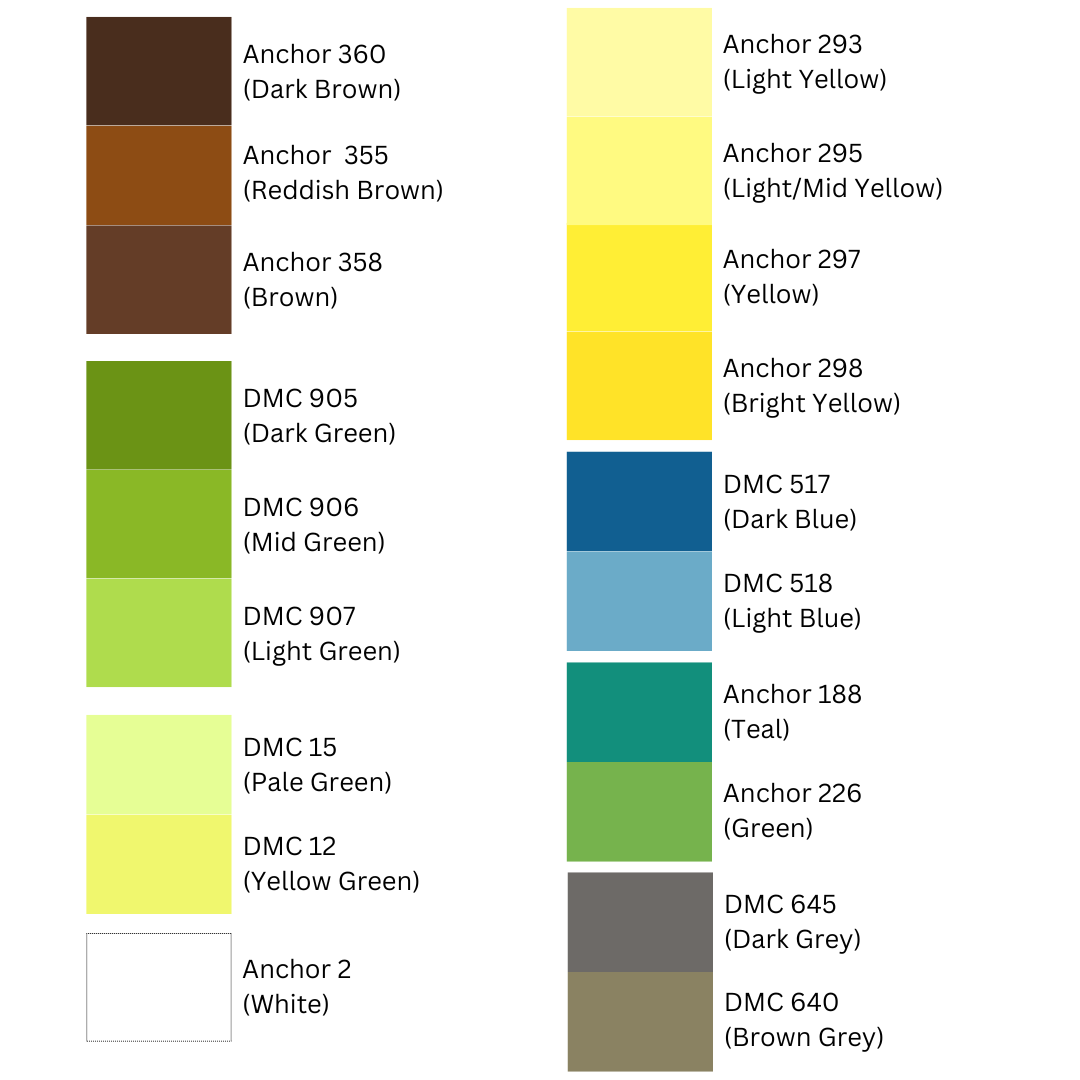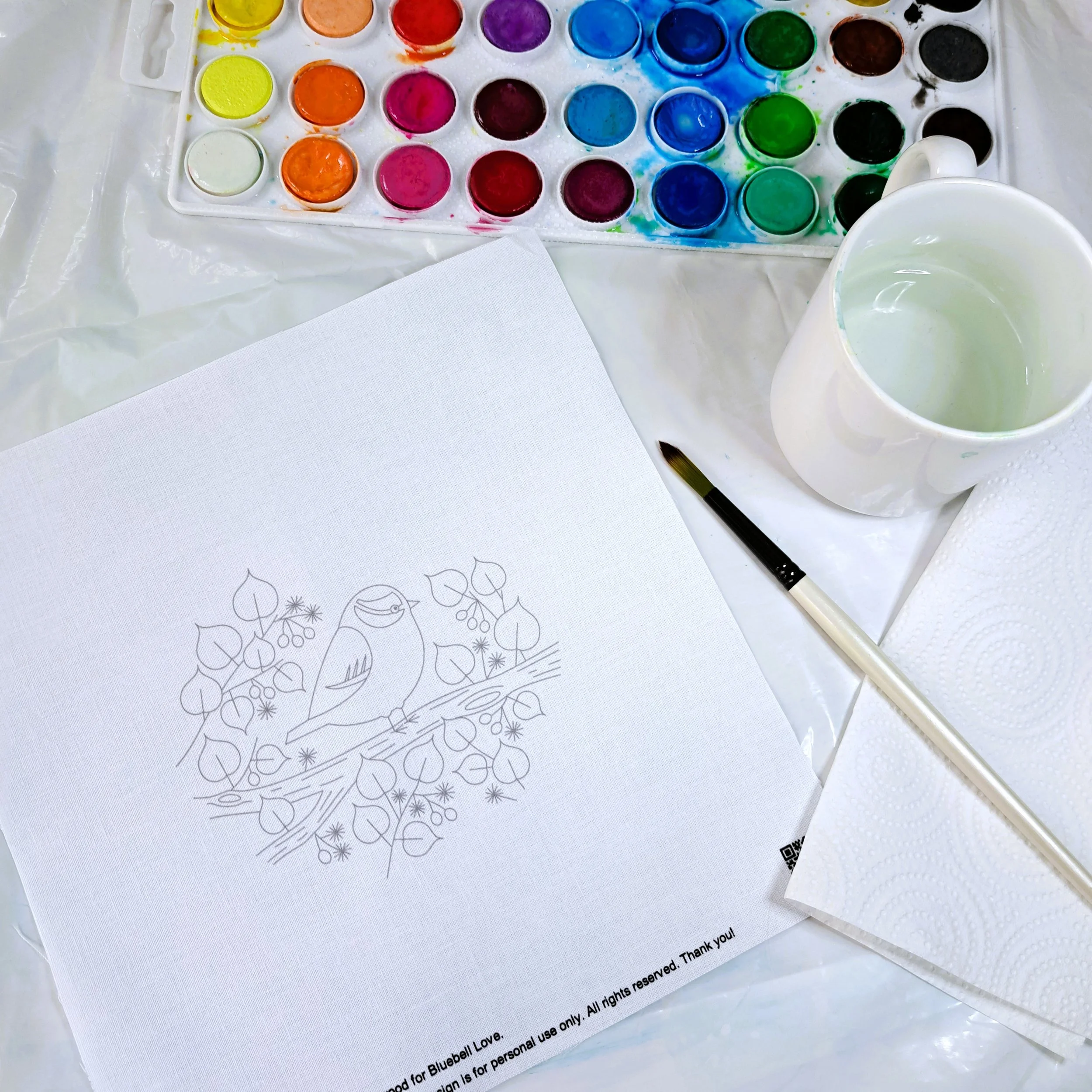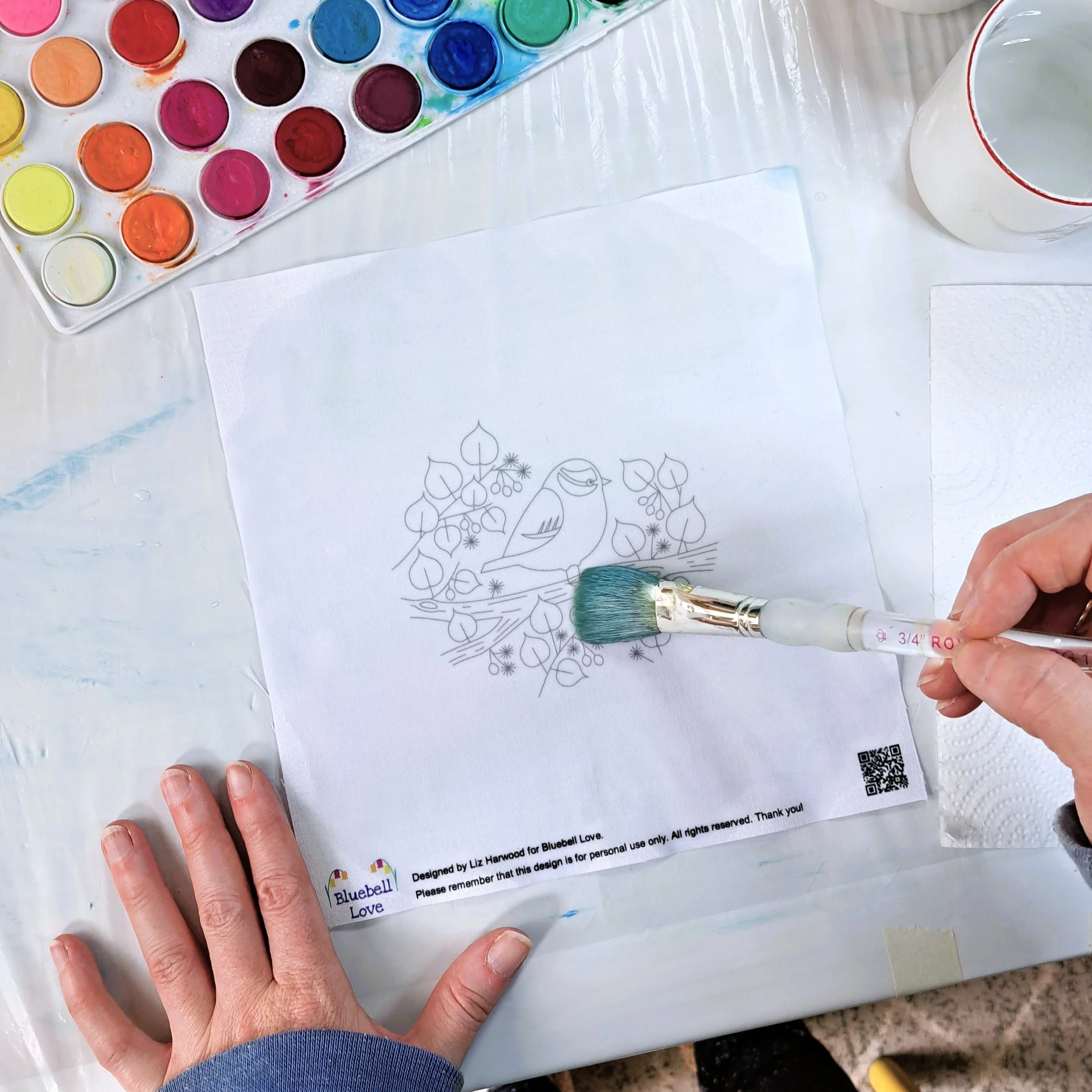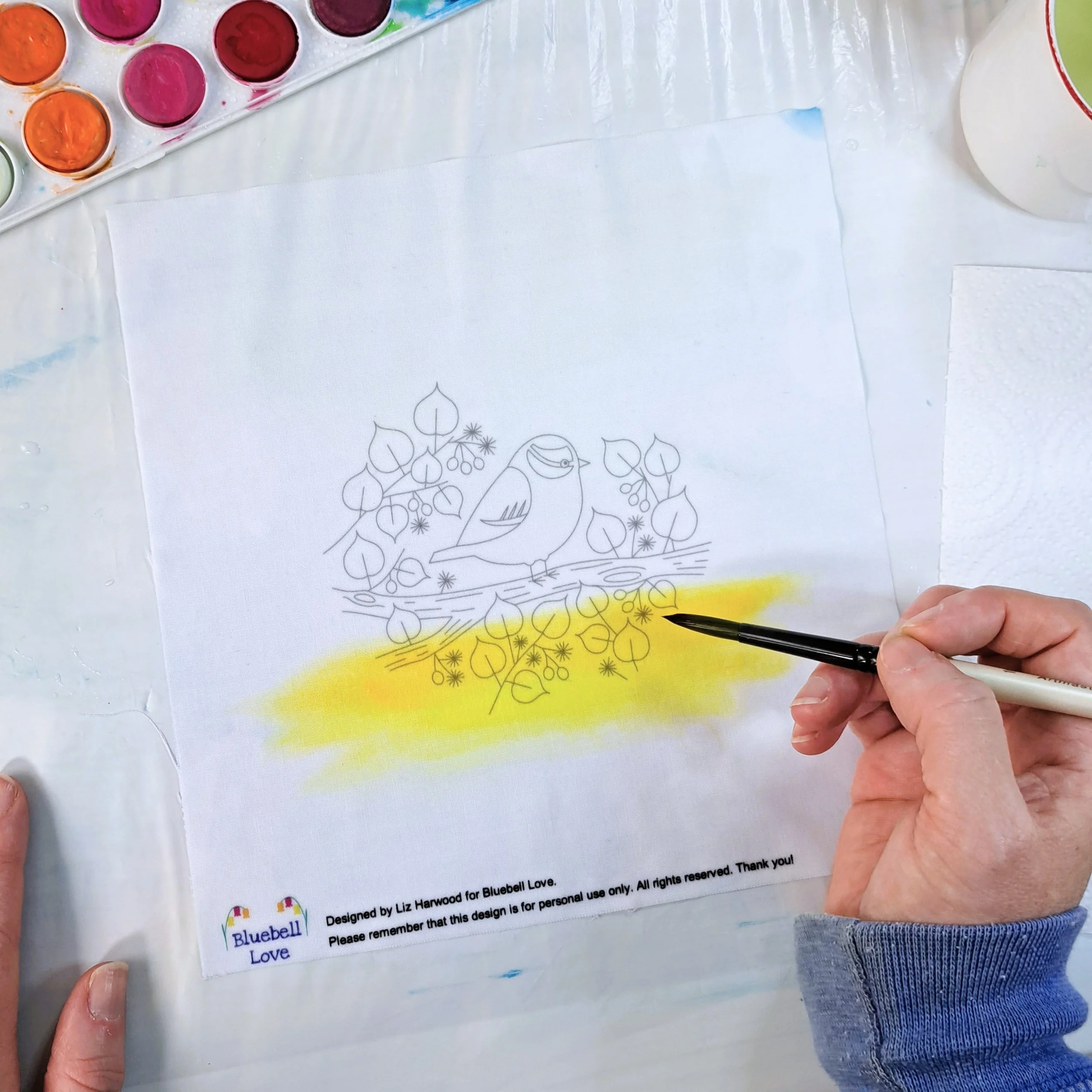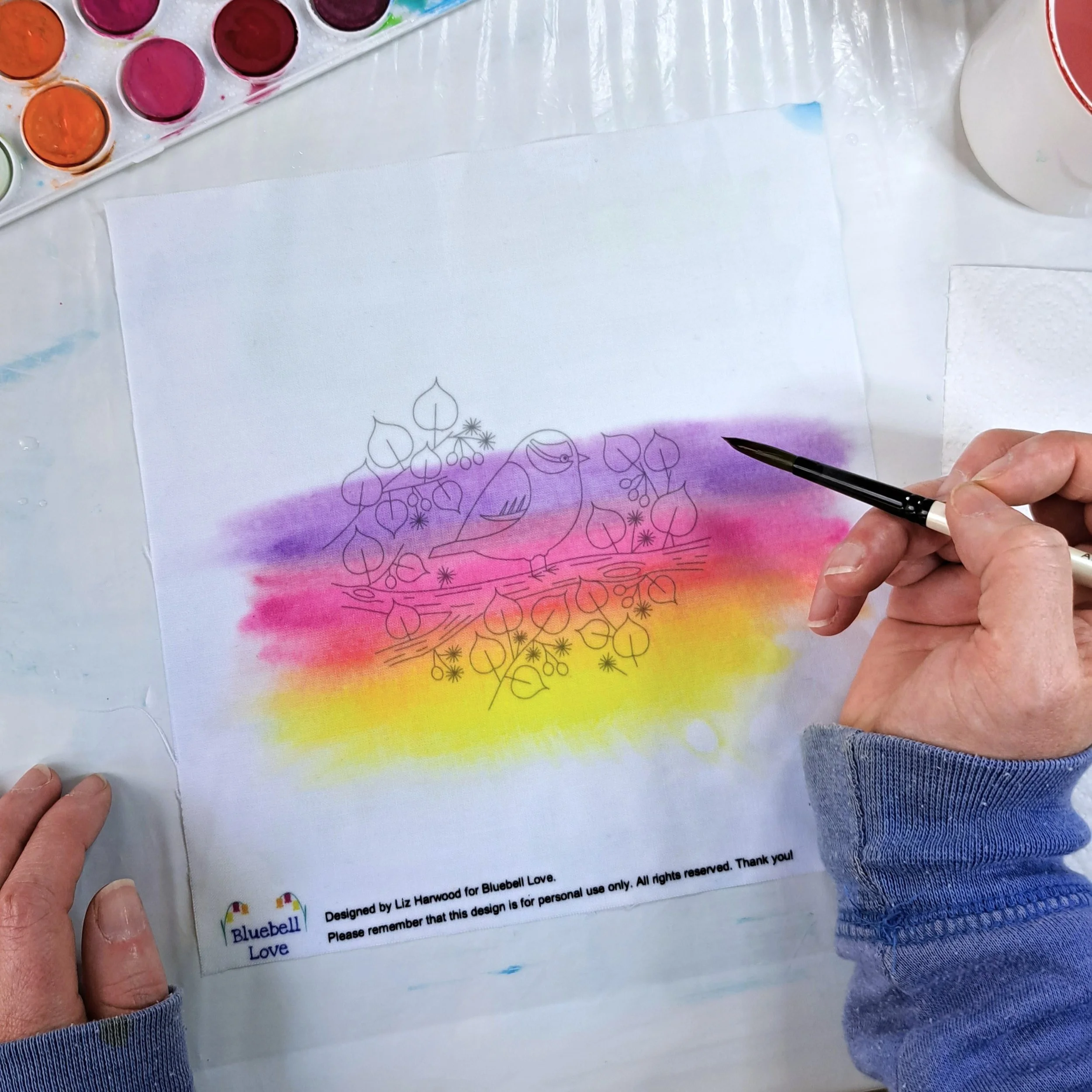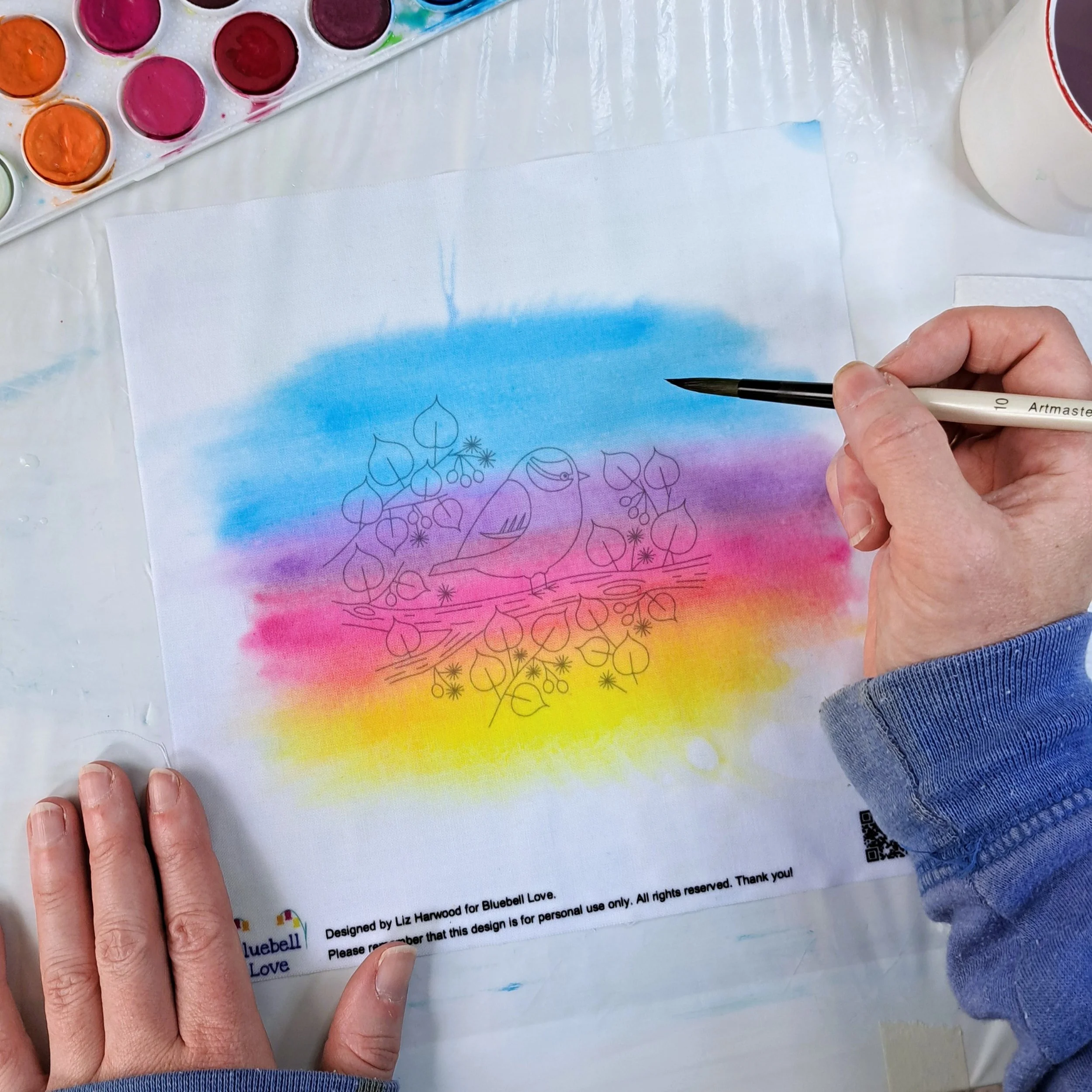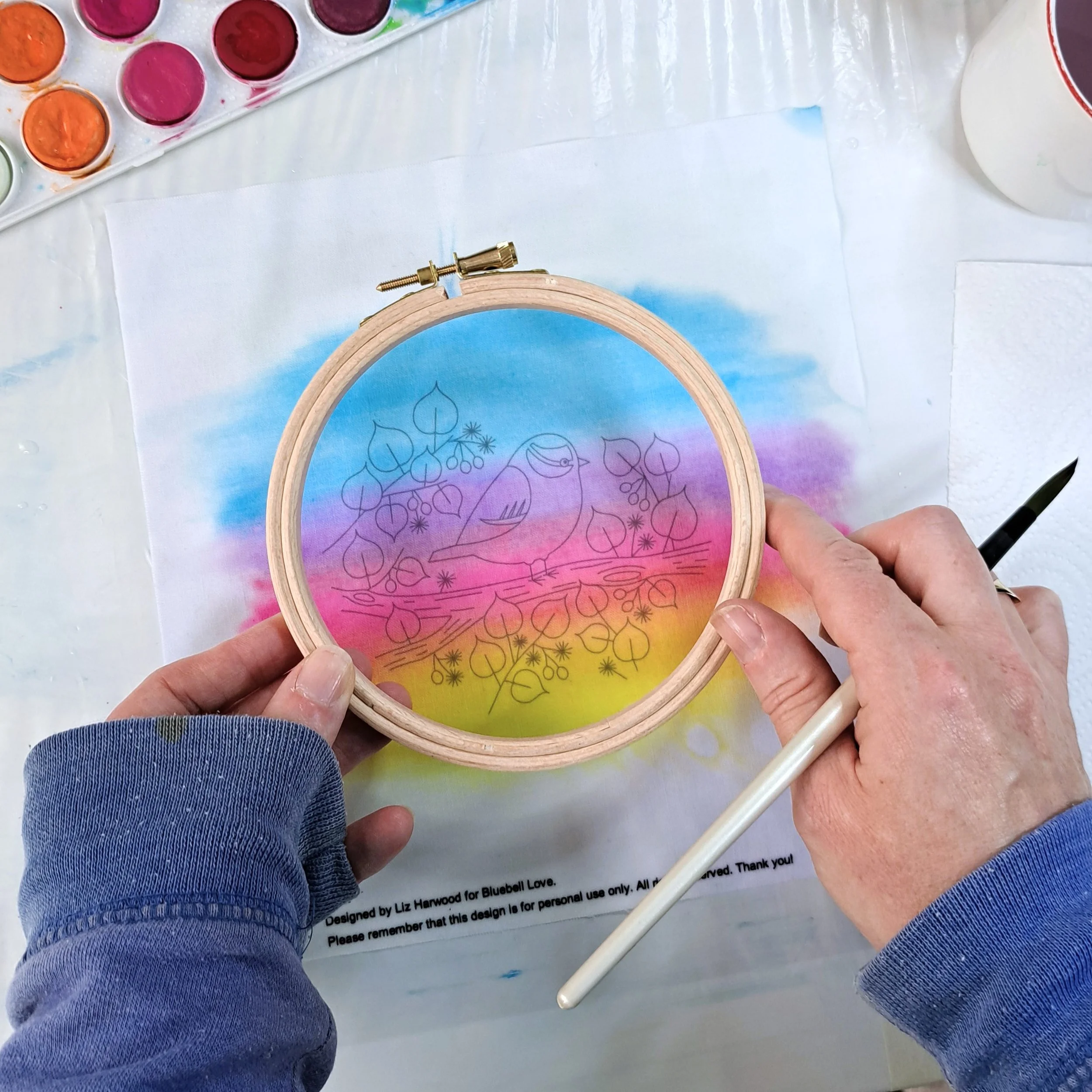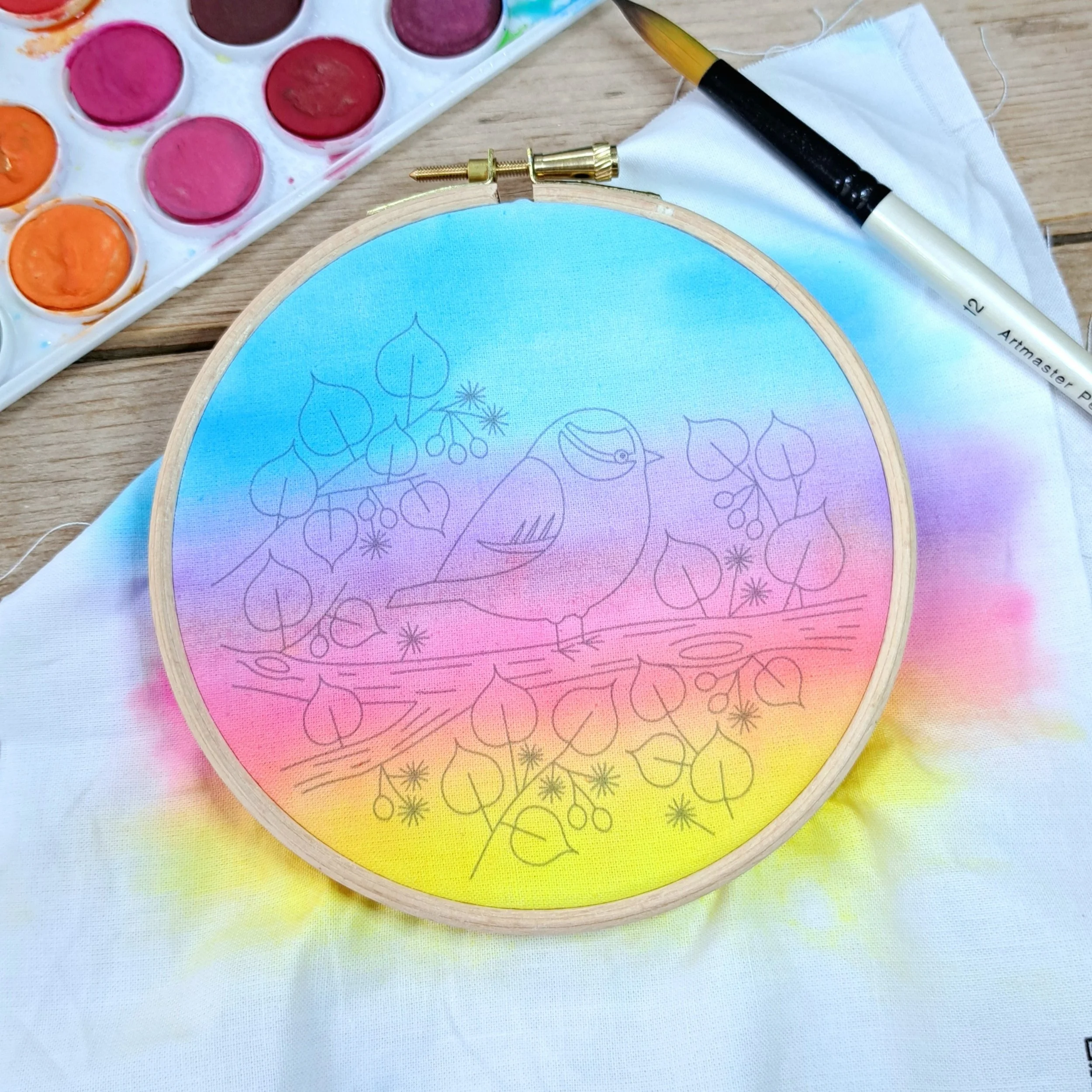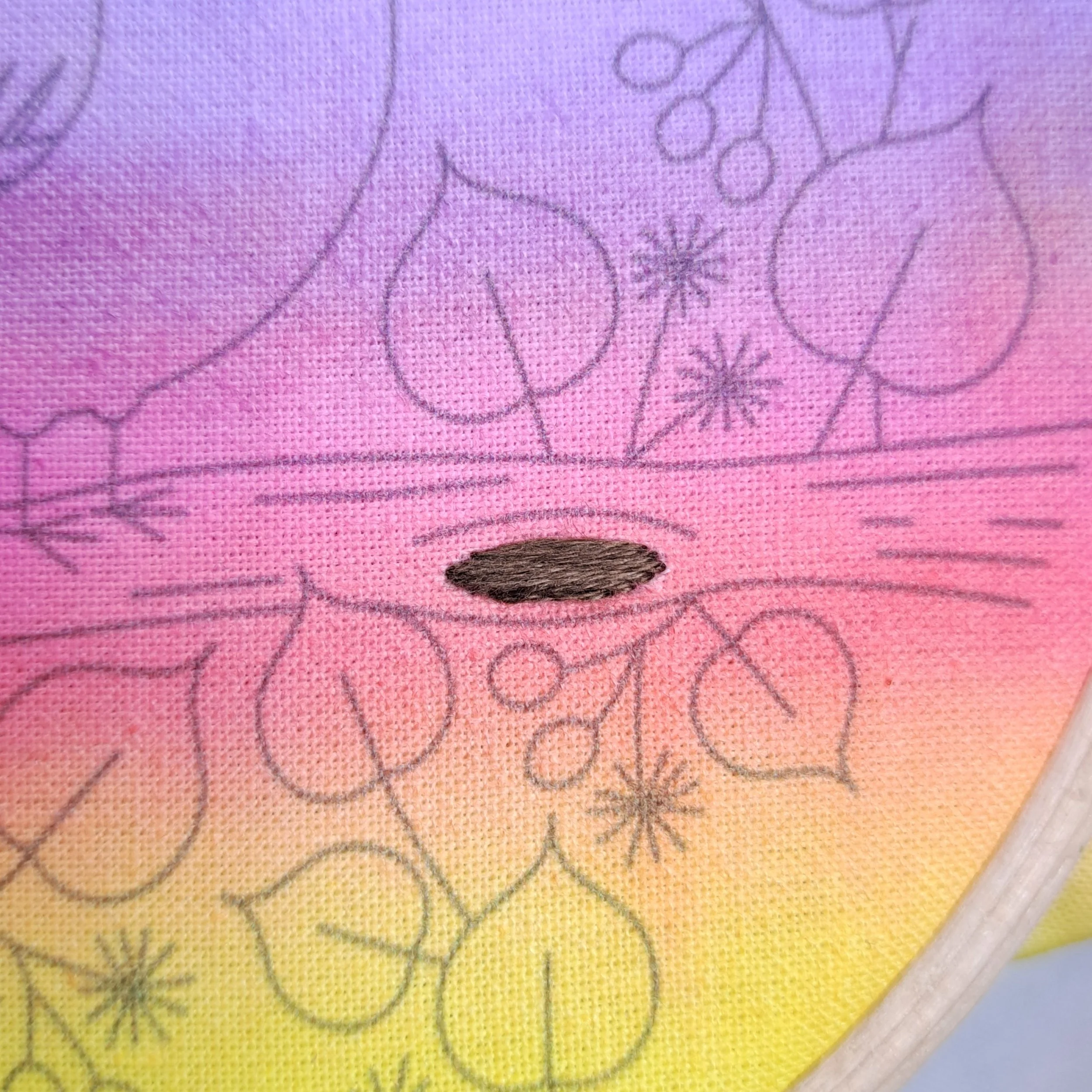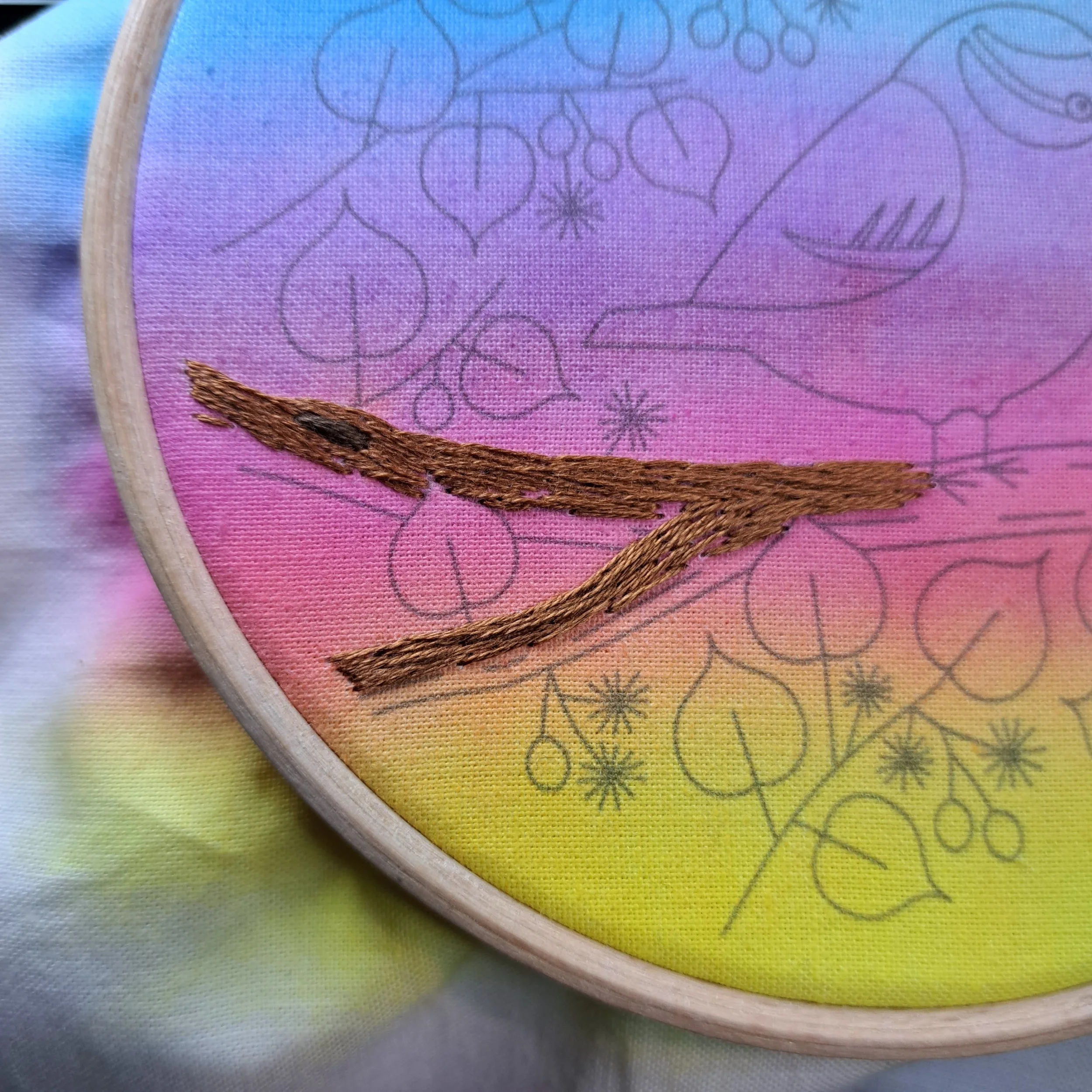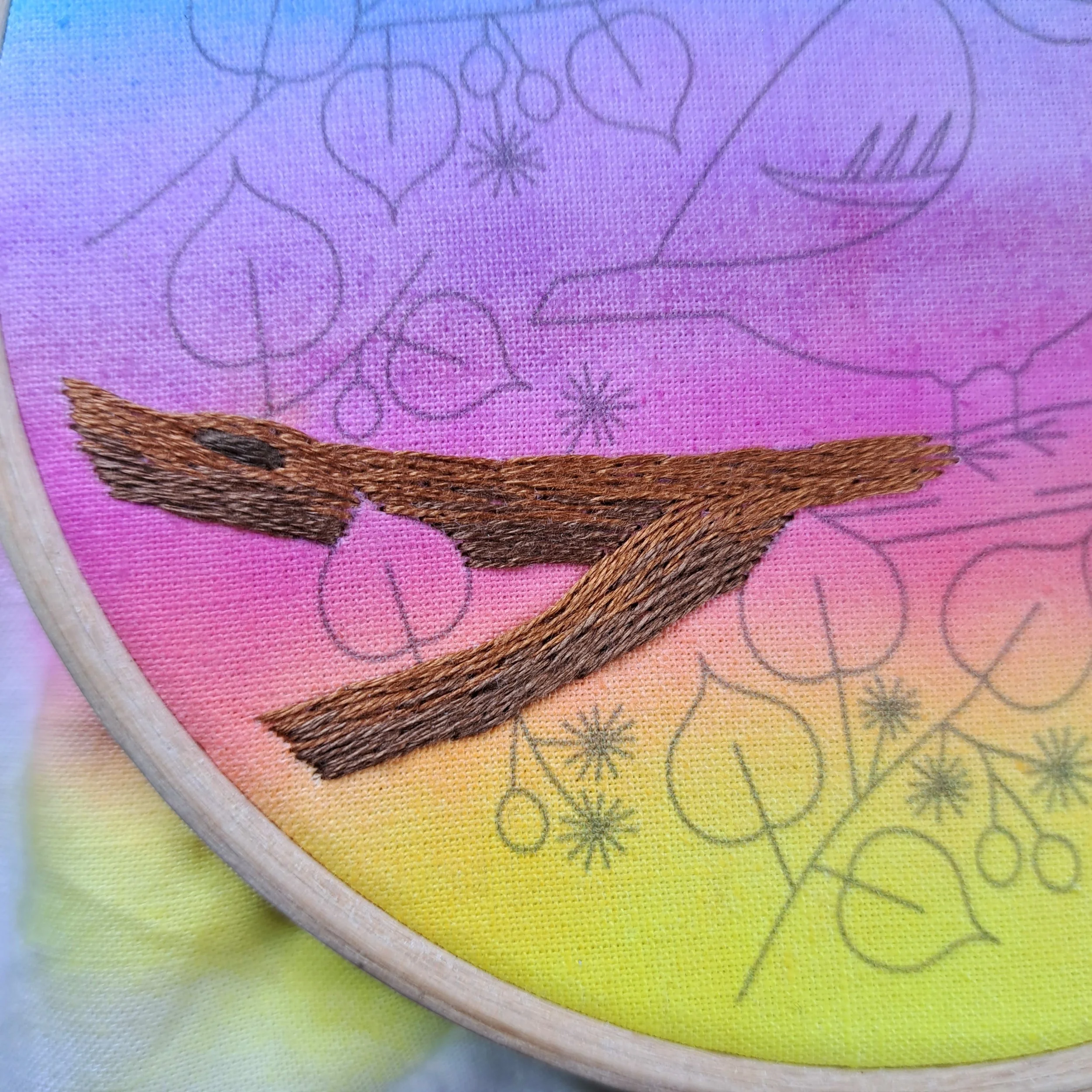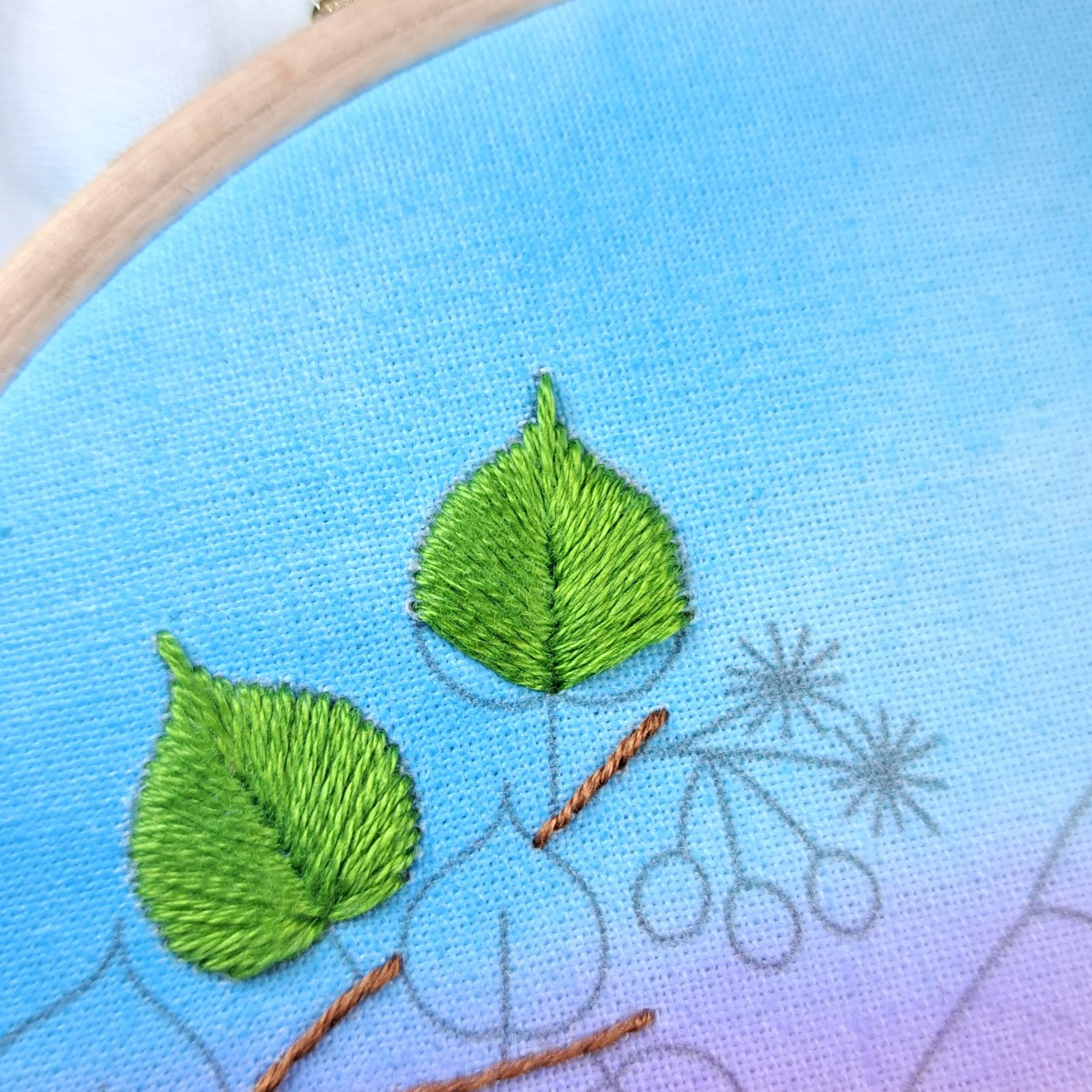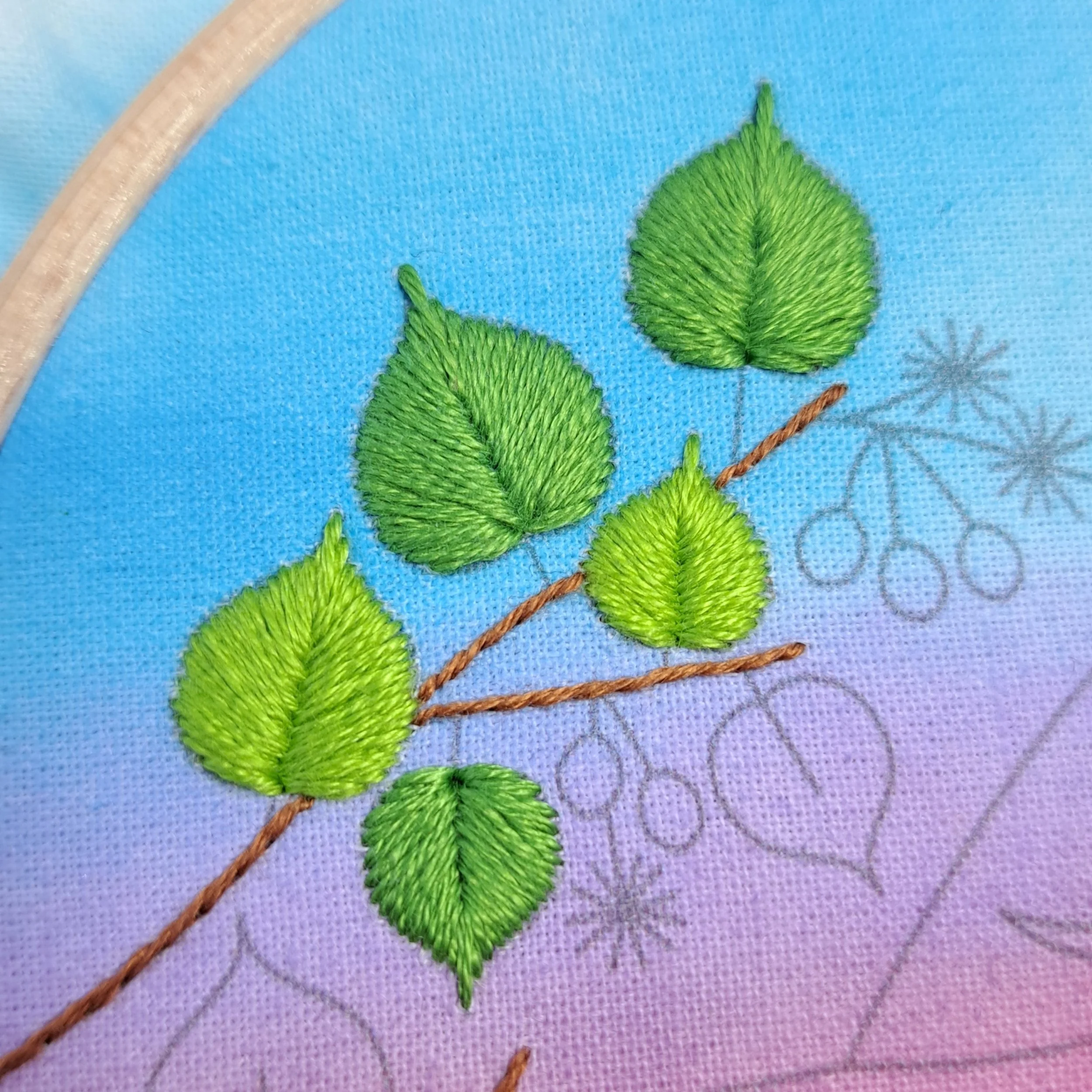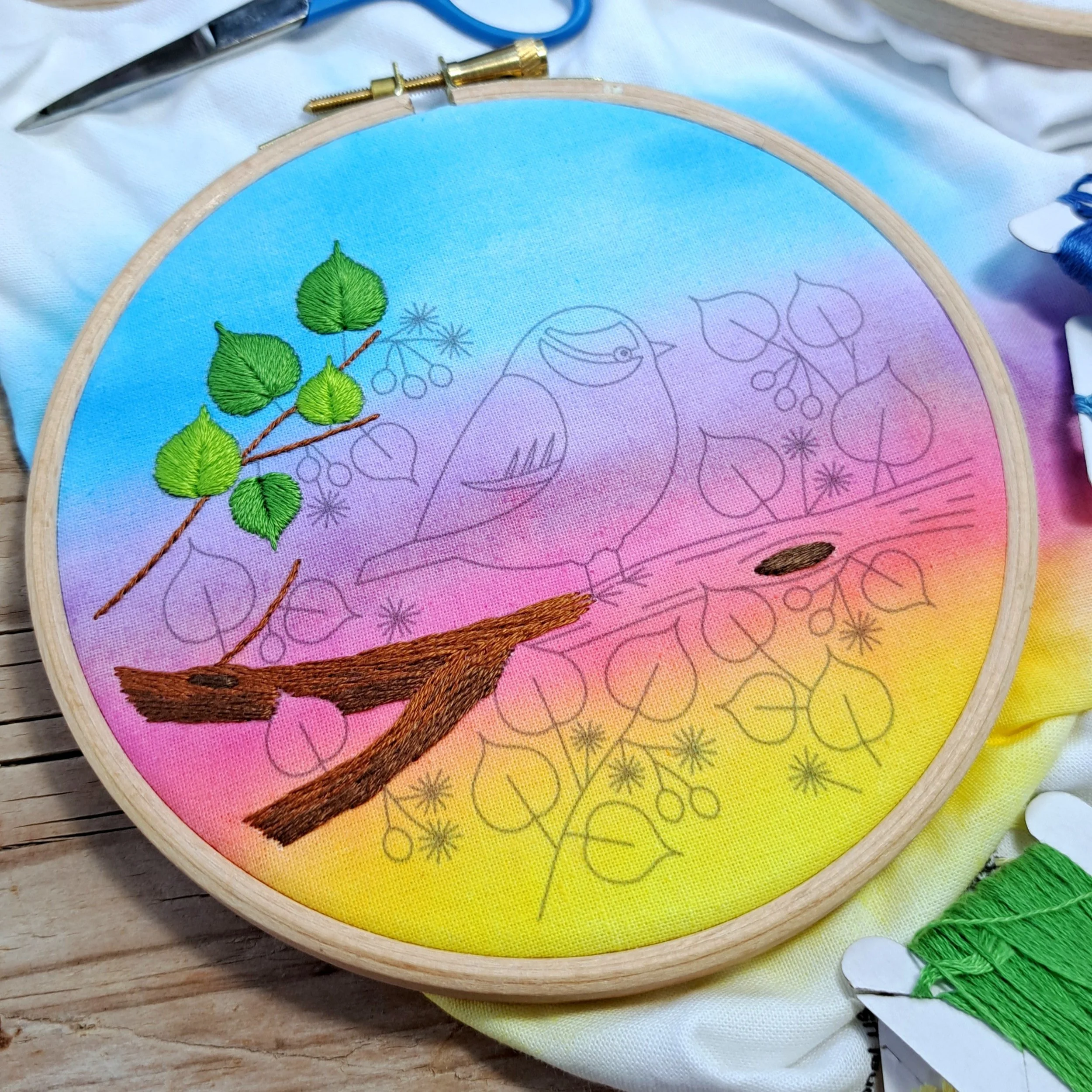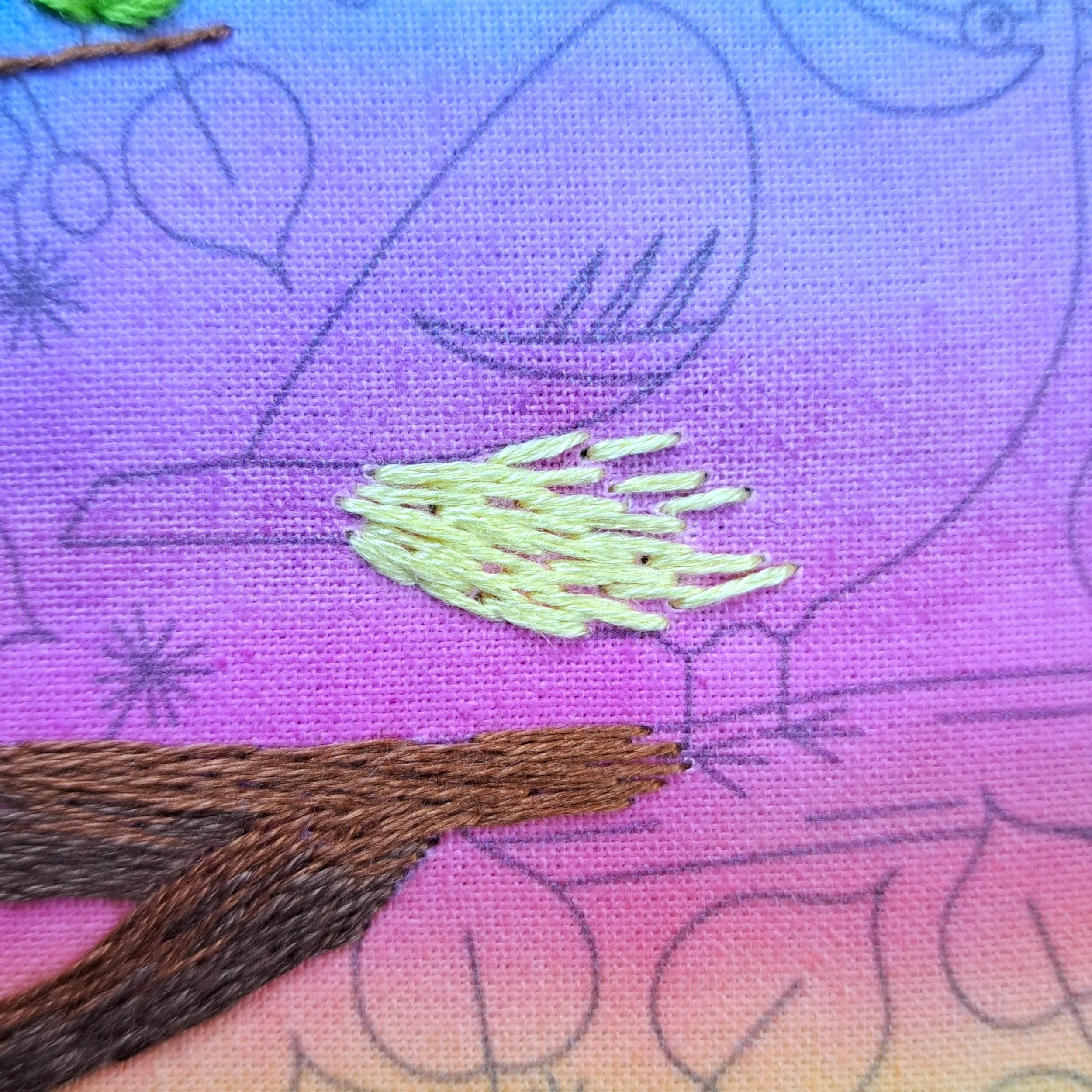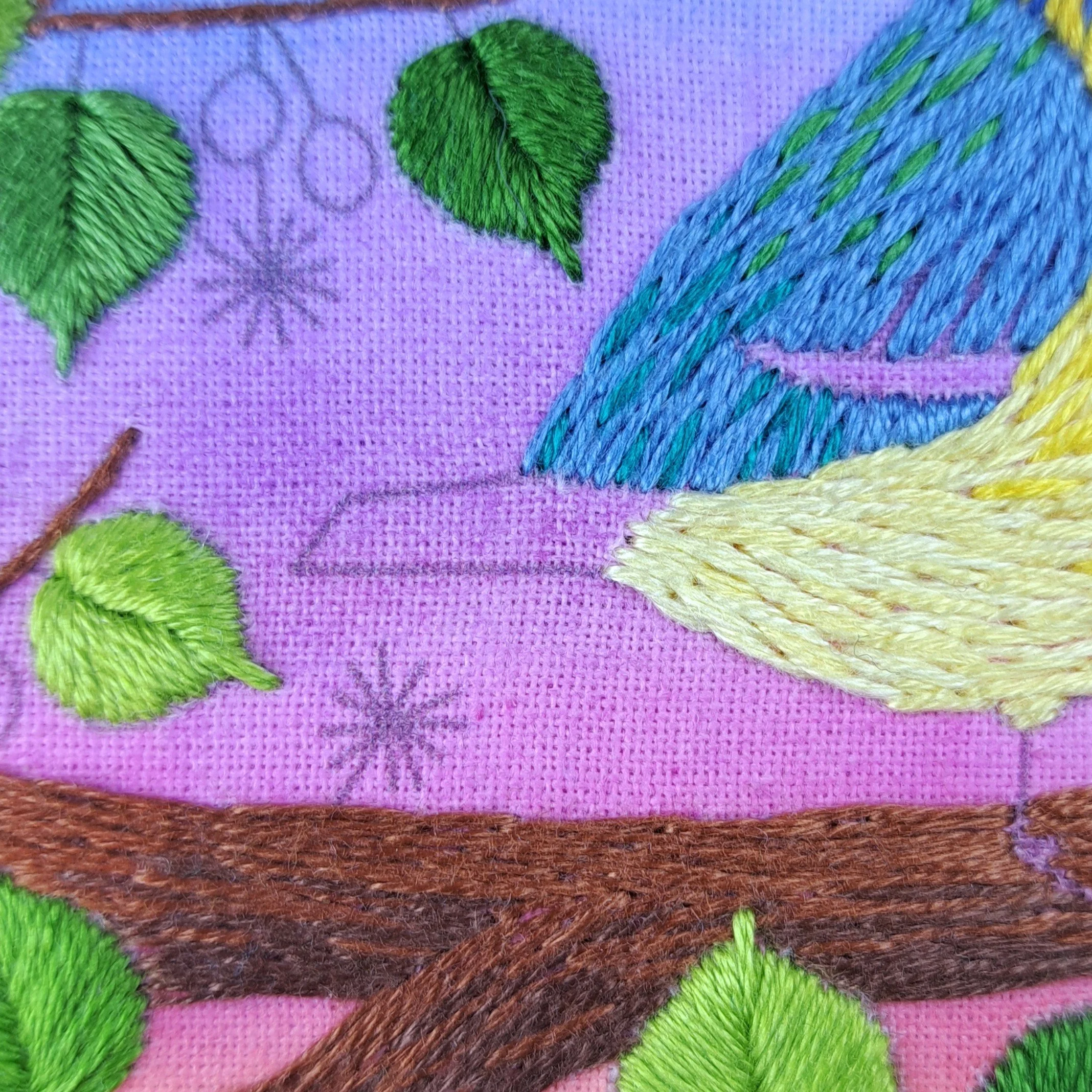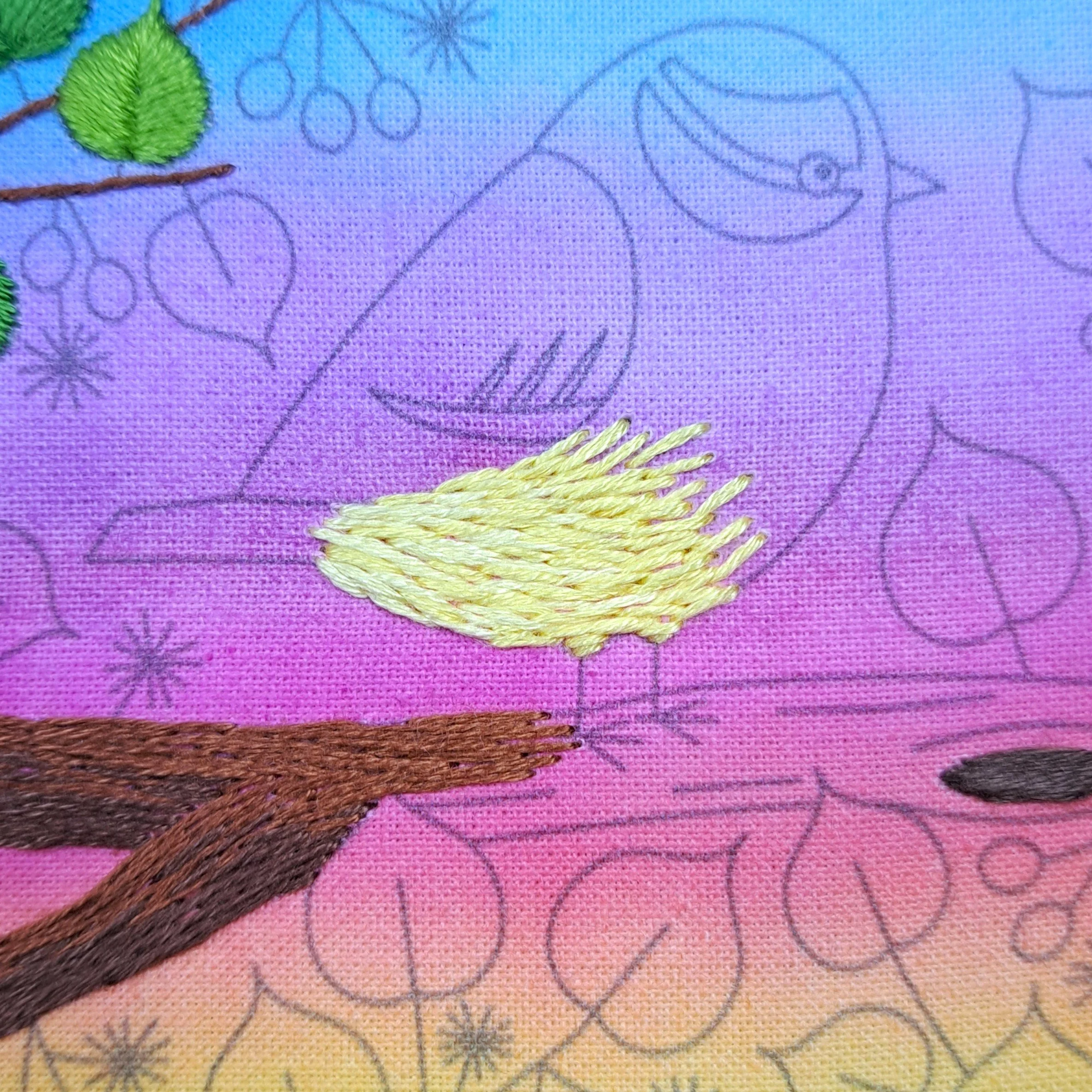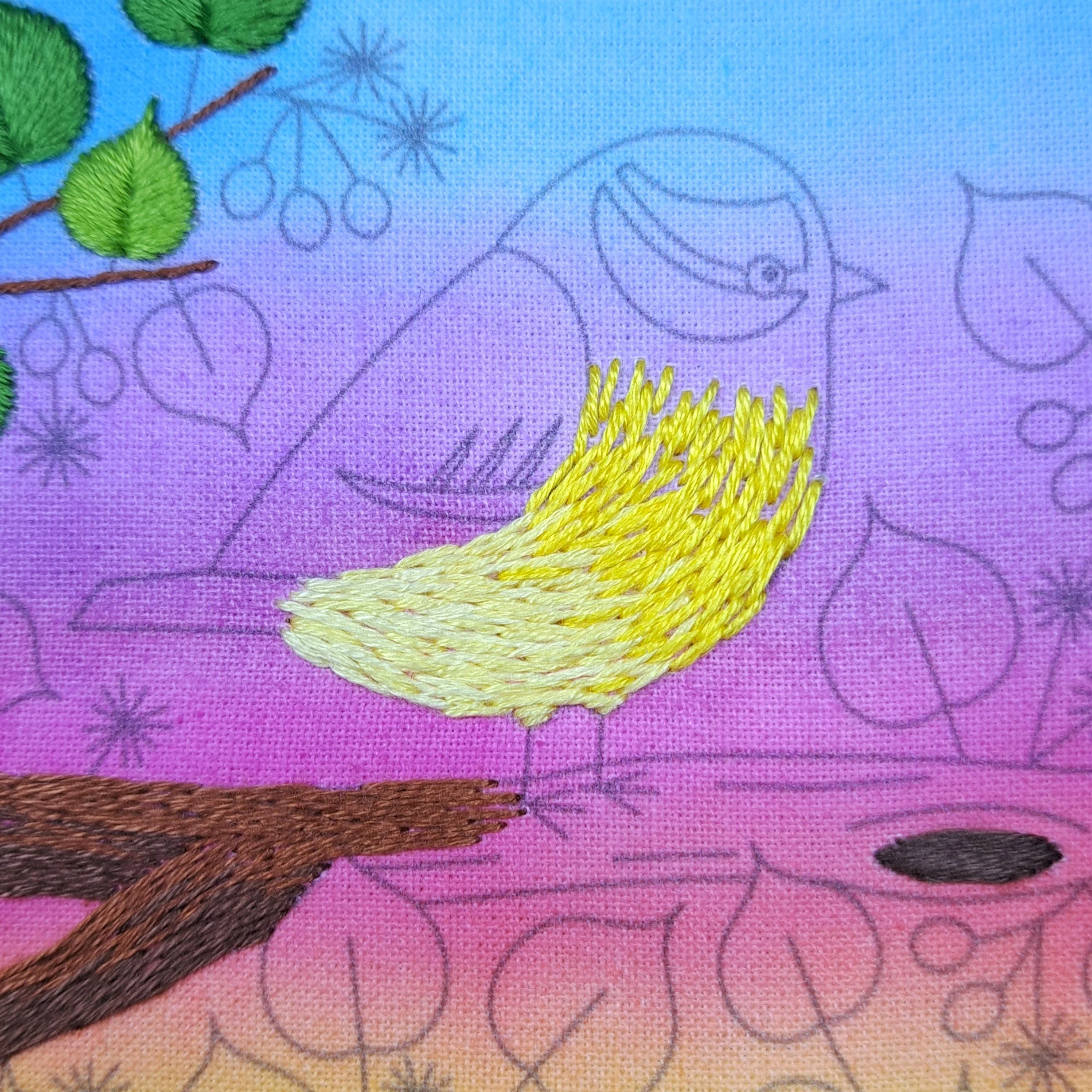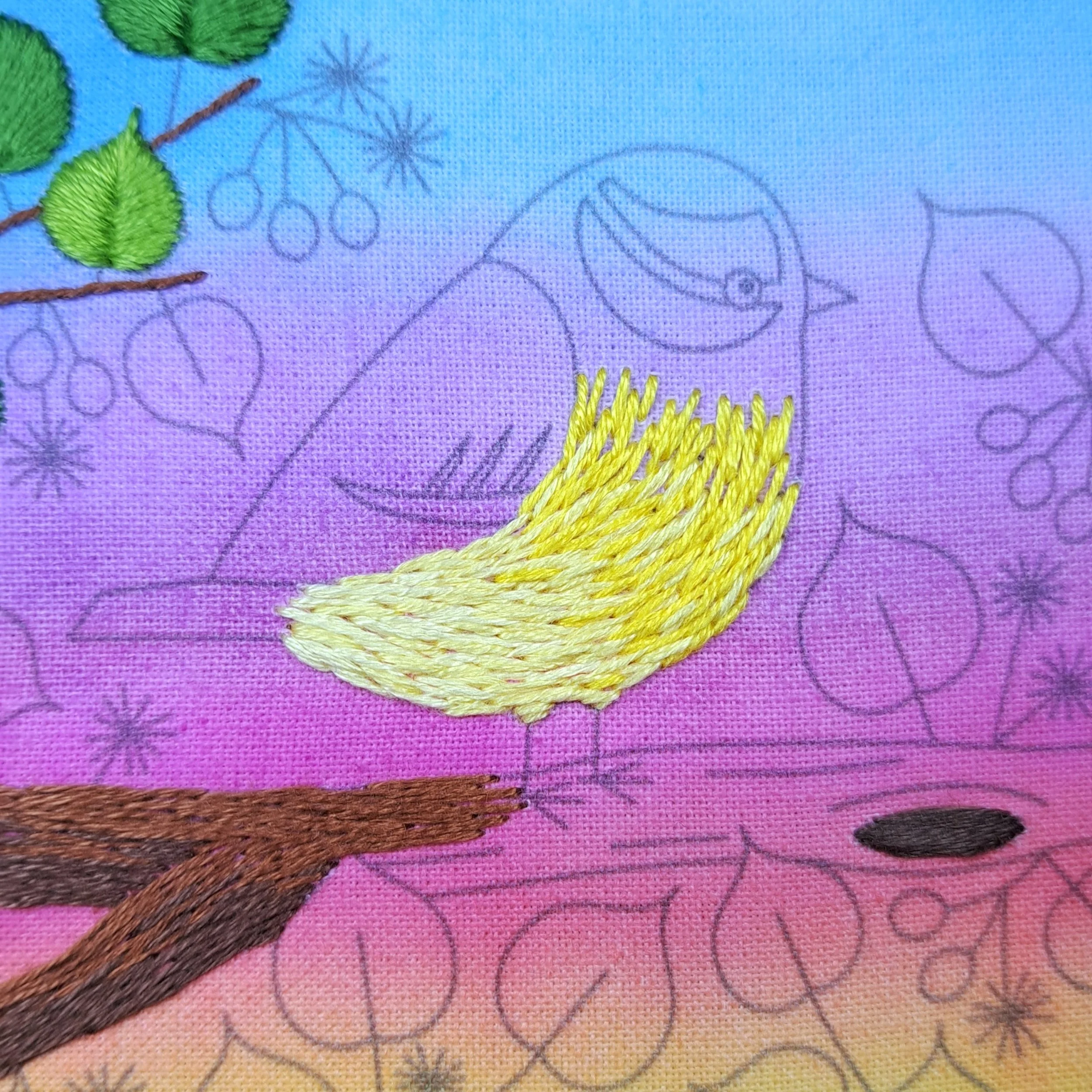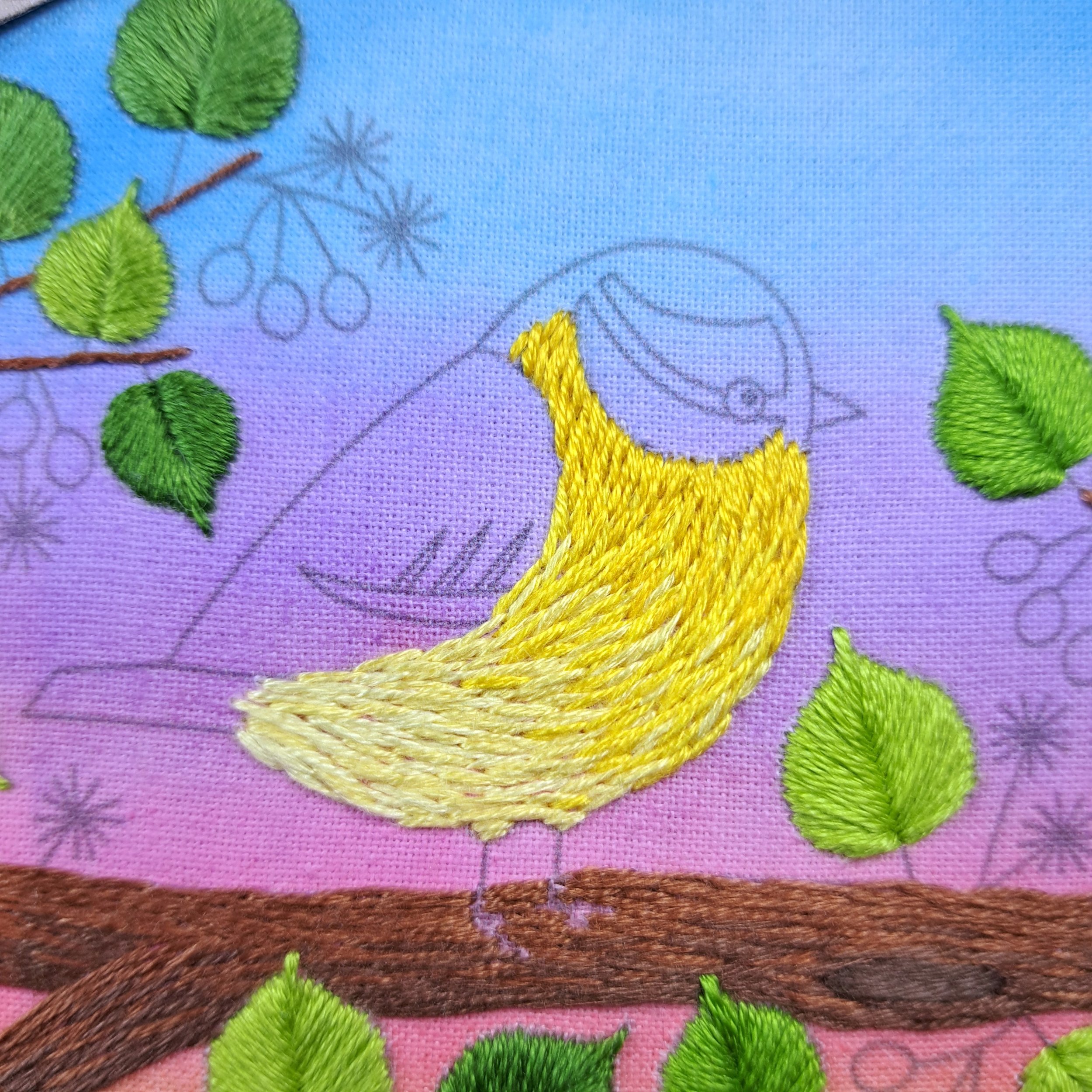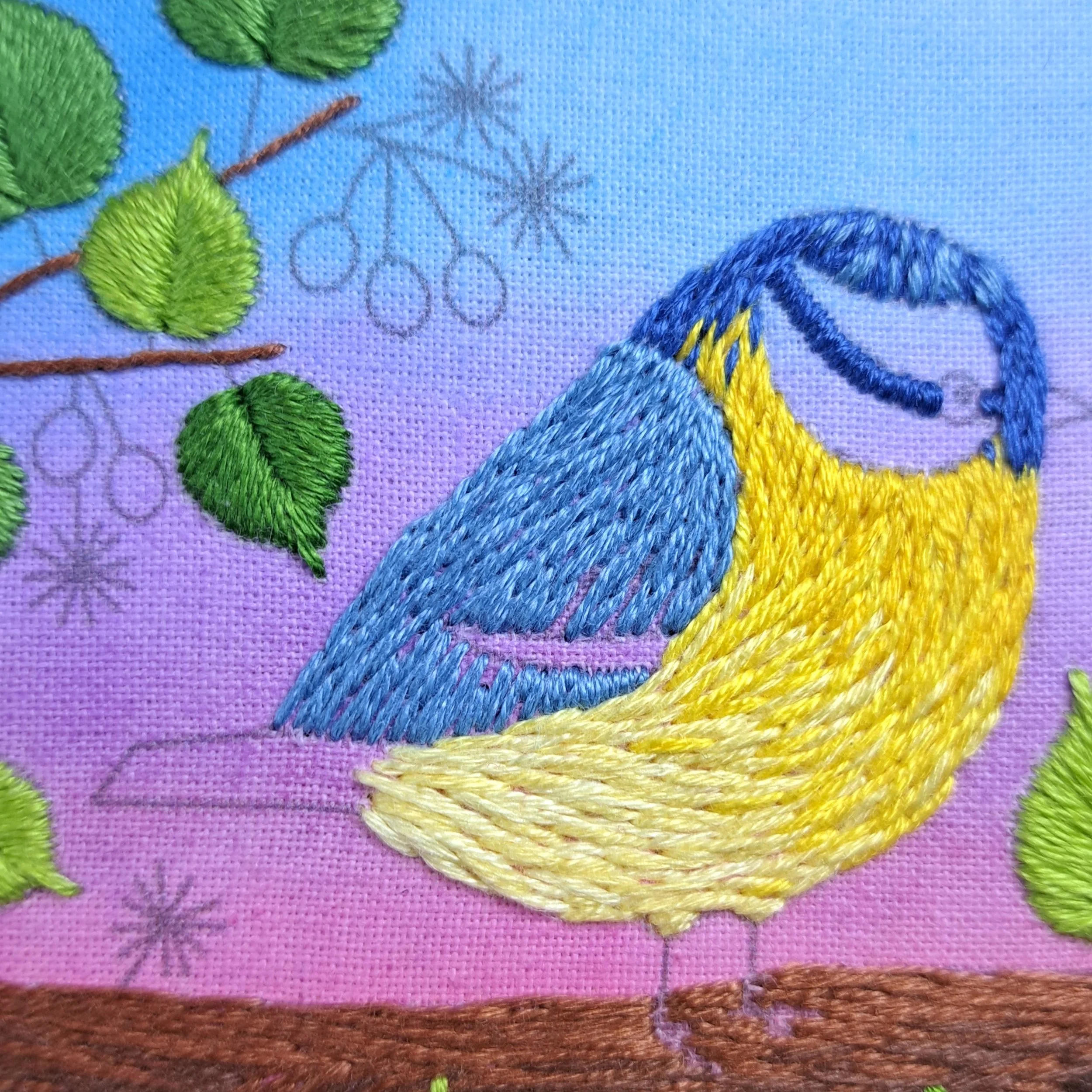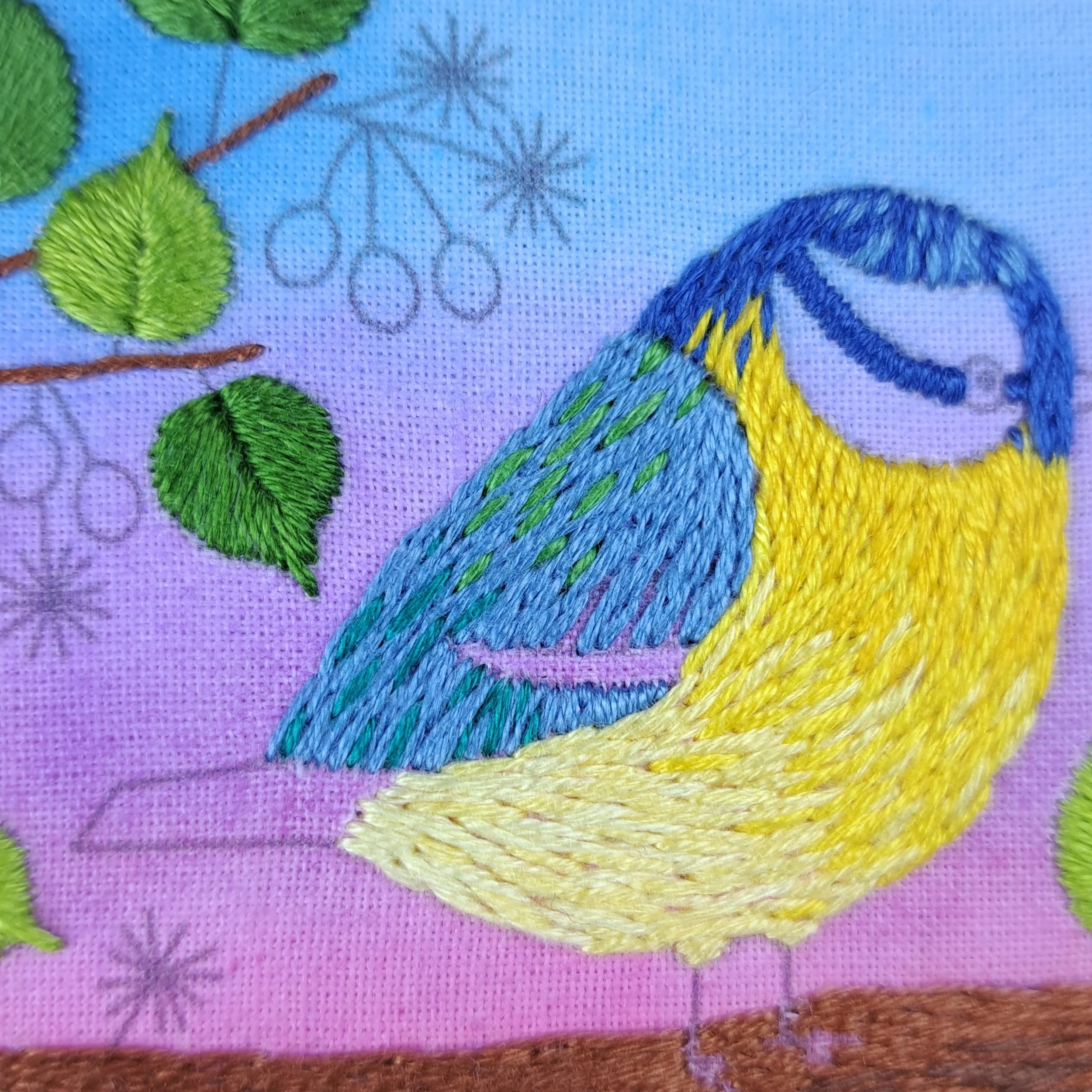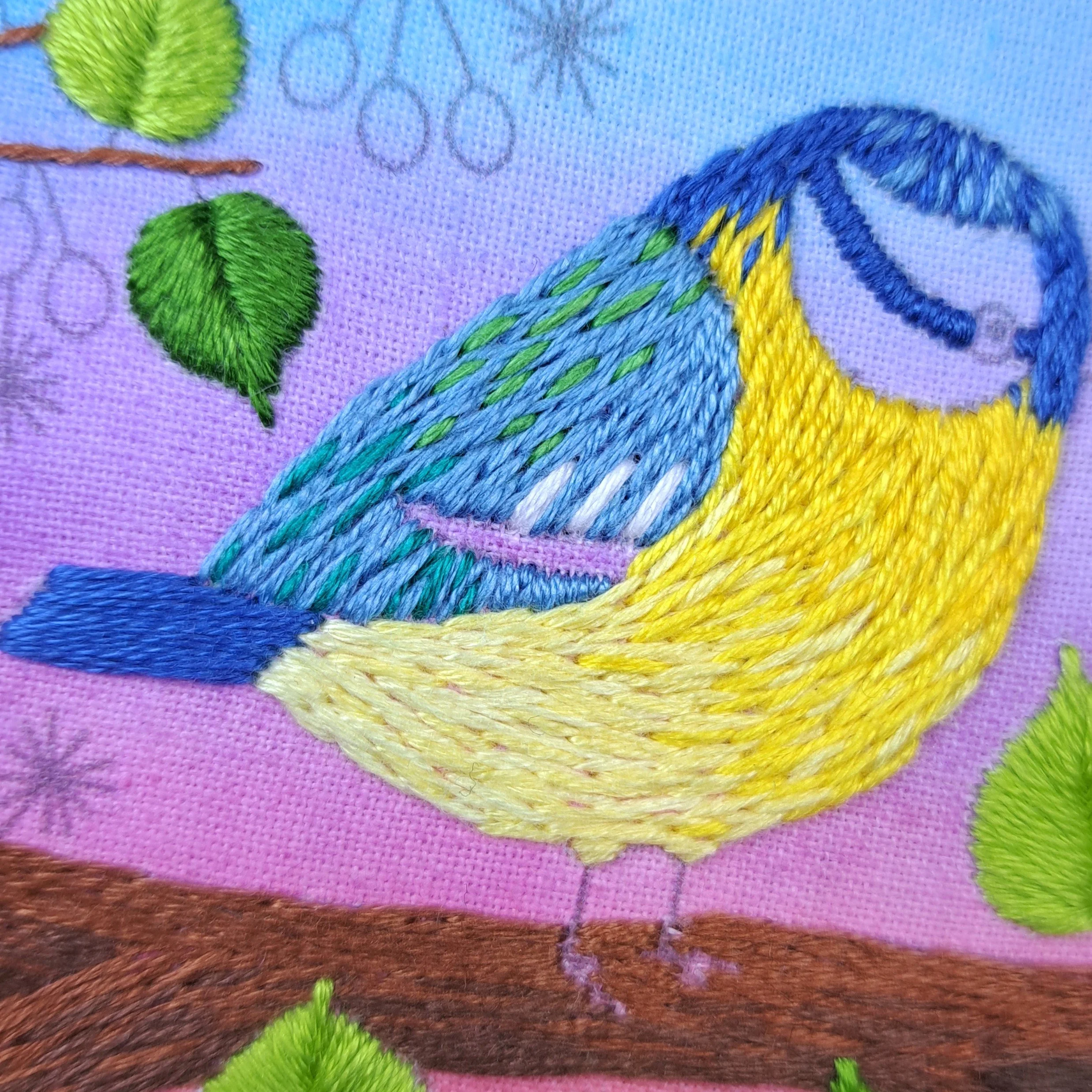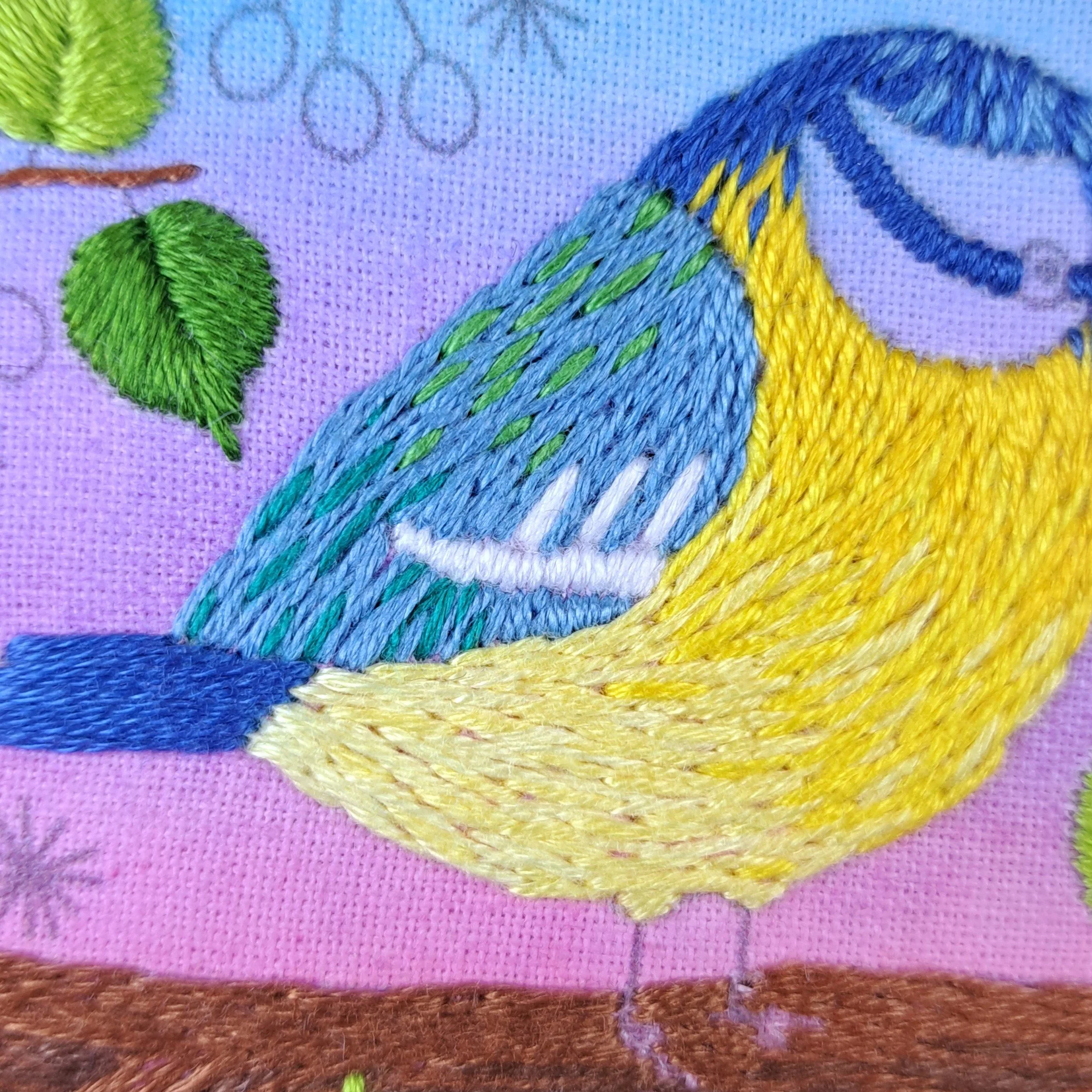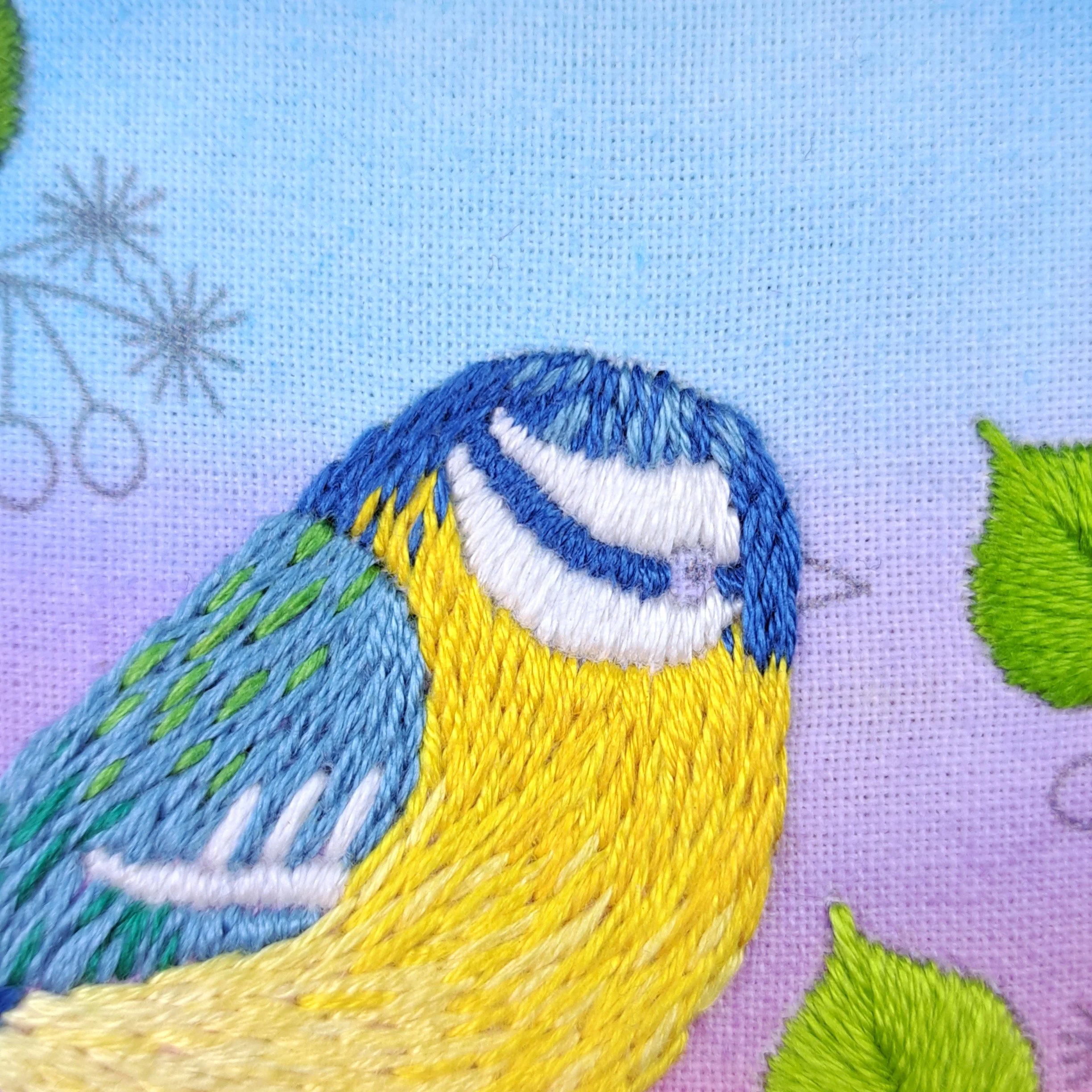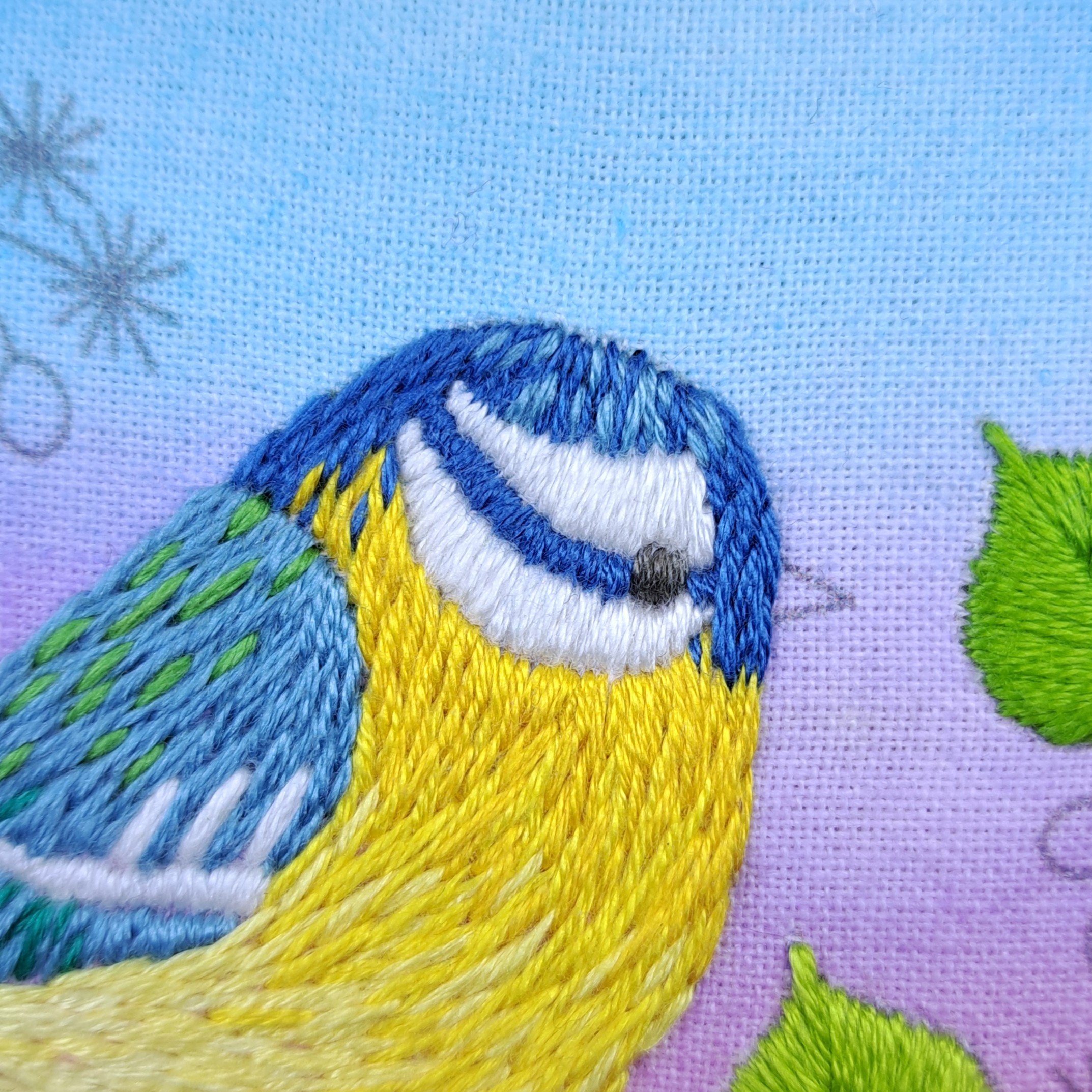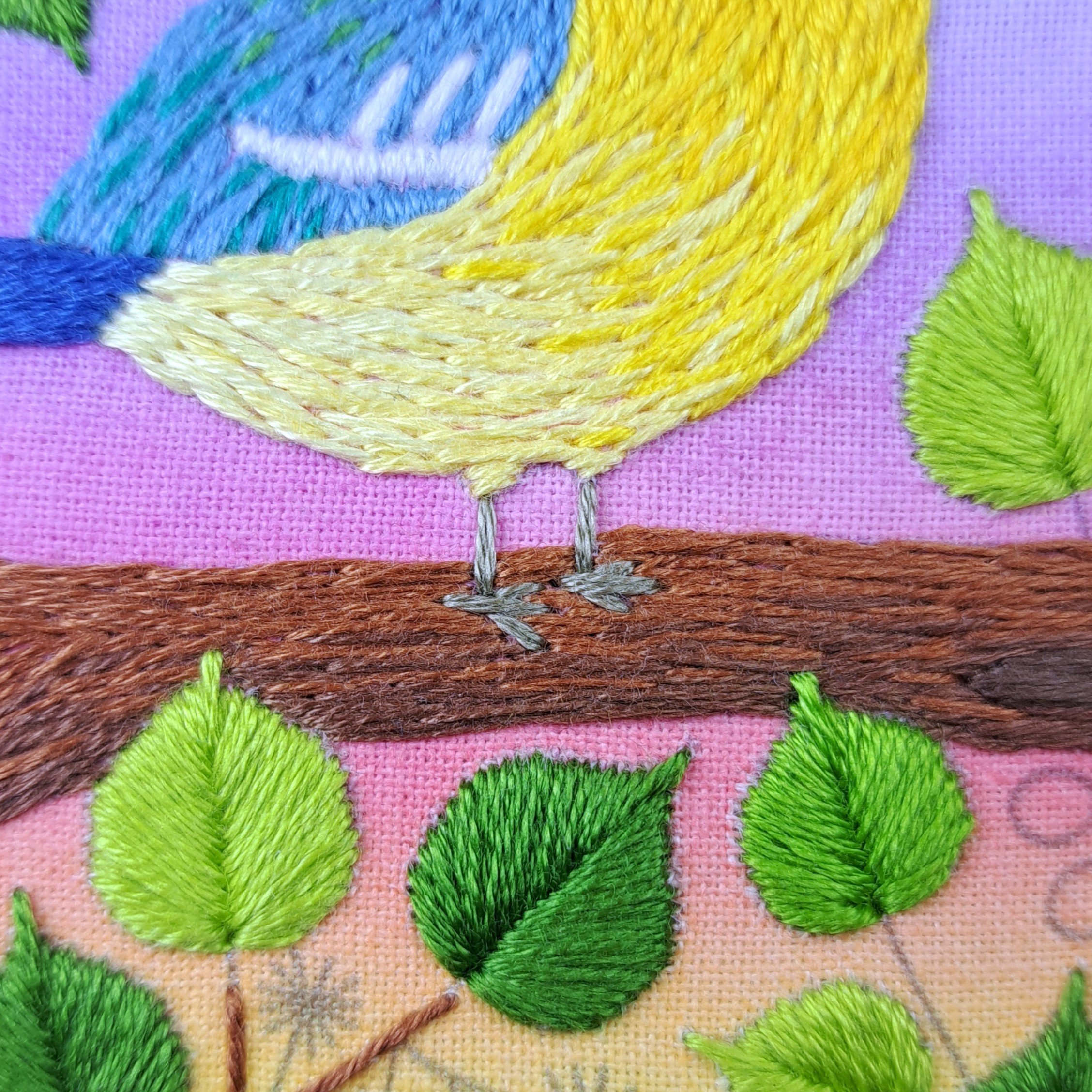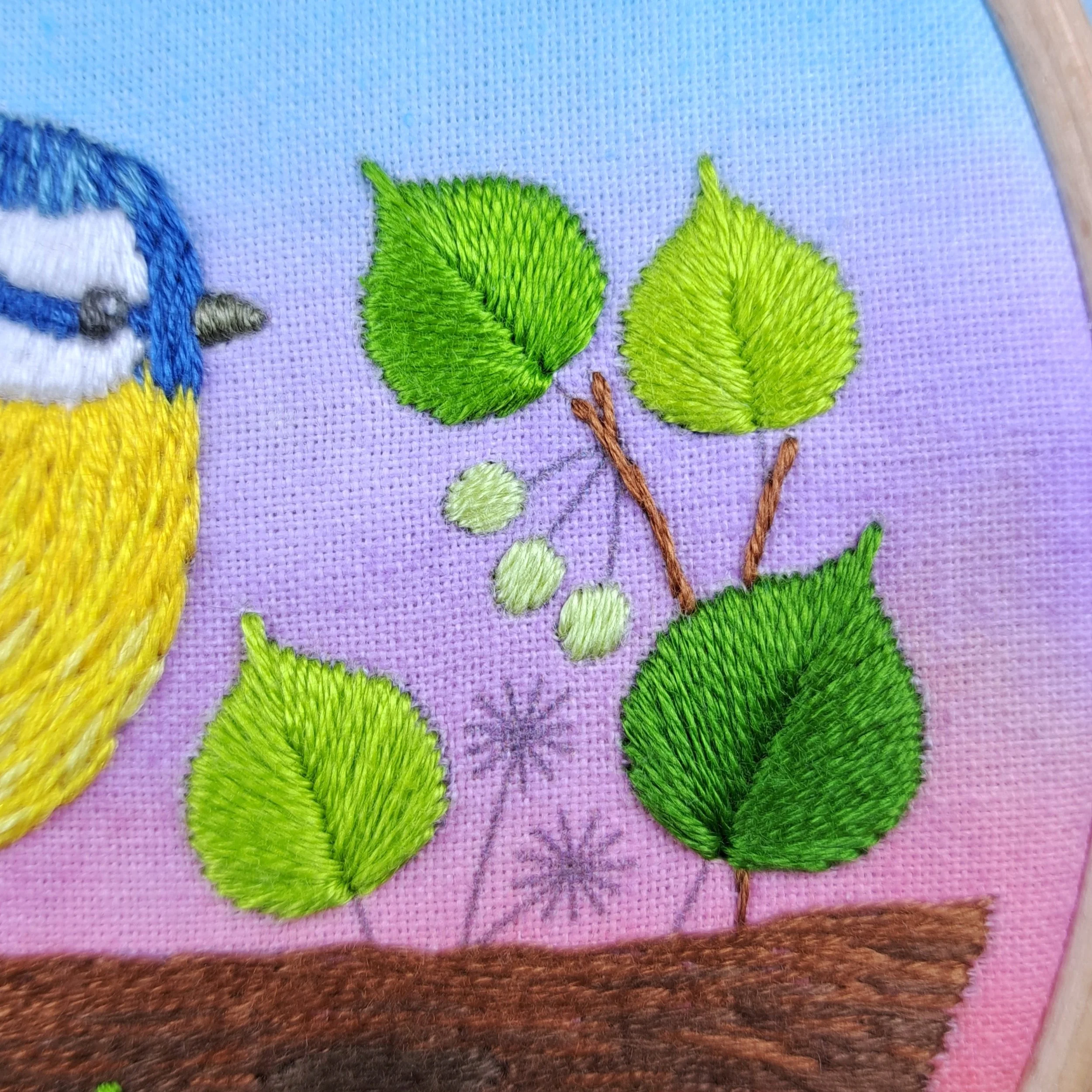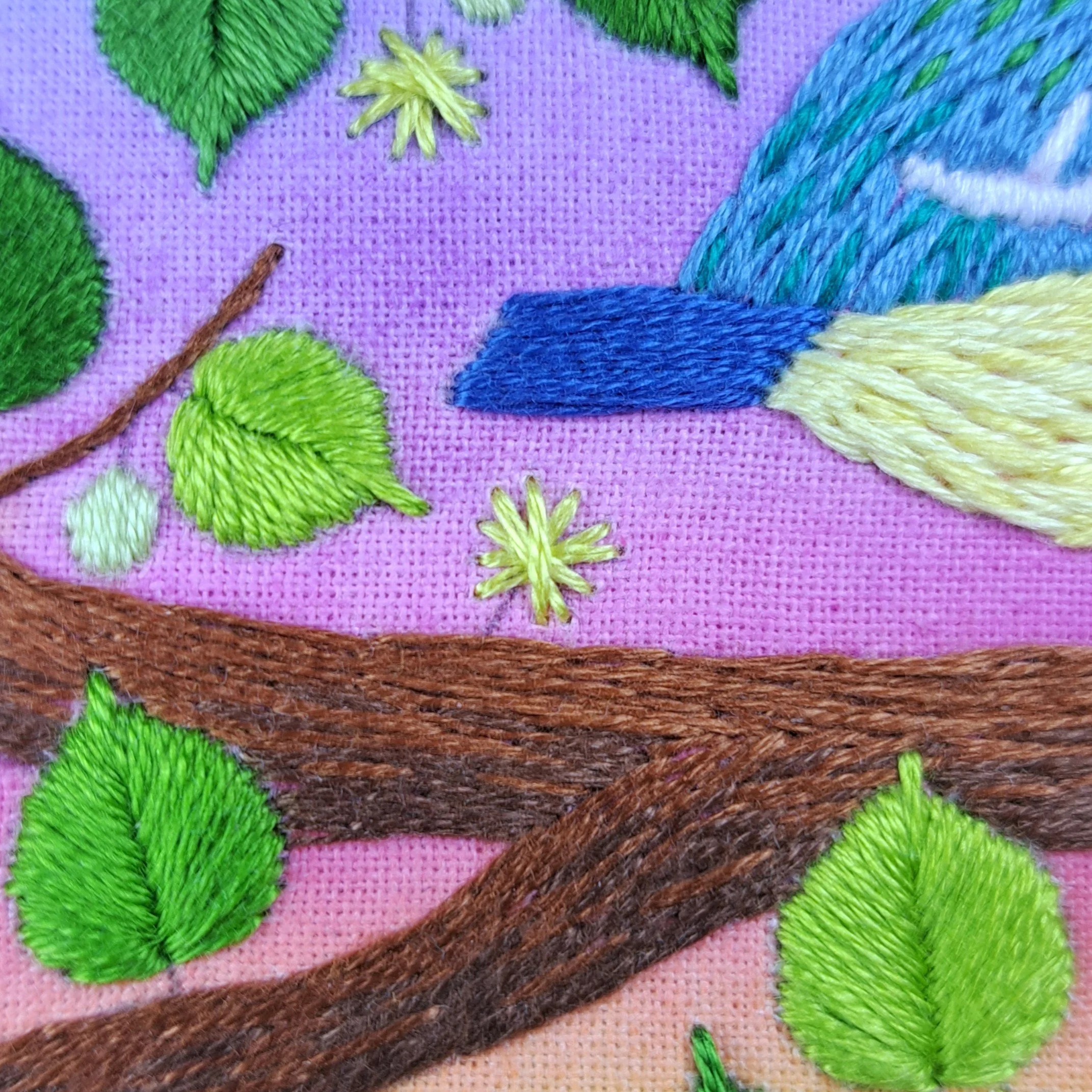How I Stitched the Blue Tit Panel: A Step-by-Step Guide
Oh I think this one turned out so pretty and cheerful! I’ve been playing with watercolour paints again for the background — it’s such a fun way to add colour without stitching every inch, and there are so many ways you could experiment with it. 🤩
This Blue Tit is the first of five garden bird designs I’ve been stitching since I redesigned my panels, and I really loved every minute of it. Although all the birds are different (and standing in different trees), you could stitch any of them the same way I stitched this Blue Tit. I’m planning to stitch the whole flock eventually, but since Blue Tits are one of my favourites to watch from the studio window, it felt like the perfect place to start.
If you’ve just stumbled across me and my embroidery panels – hello and welcome! I’m Liz – the illustrator, maker and stitcher behind Bluebell Love. I’ve been stitching for many, many years now, and like most stitchers, I’ve built up quite the stash of embroidery threads. Some I bought because I just had to have the colour (magpie instincts), others are leftovers from kits, some were gifts, and a few I’m convinced just magically appeared 😏. And if you’re anything like me, I’m guessing you’ve got a good stash growing too!
That’s exactly why I created these embroidery panel designs – they’re pre-printed, so you can pop them straight into a hoop and get stitching, using all those lovely threads that deserve to be seen (not hidden away in a box!).
And just like with all of my embroidery panels… there are no rules 😄. Use your favourite colours, your favourite stitches, and stitch as much or as little as you like. Just the outlines, a few pops of colour, or go full-on and cover the whole panel.
For this embroidery I used 19 thread colours from my stash (yes — nineteen!). You absolutely don’t need that many — the more the merrier if you’ve already got them, but it will look lovely with fewer too. I had so much fun blending the yellows and adding layers of blues and greens on the little bird.
Now that the Blue Tit is stitched, I’ll walk you through exactly how I did it in this step-by-step guide. I’ll cover the stitches, threads, needle sizes, techniques, and share a few little tips along the way. I’ll also show how I added the watercolour background — but if paints aren’t your thing, feel free to skip ahead to the stitching.
Let’s get stitching! 🪡
What You’ll Need
Time to gather your supplies! Here’s everything you’ll need to get started on your Blue Tit embroidery panel:
A Blue Tit embroidery panel
A 5” embroidery hoop
Some extra white fabric to double up inside your hoop
Embroidery needles (I’ll chat through sizes in a bit)
A selection of embroidery threads
A pair of sharp scissors
Watercolour paints
Paintbrushes
A cup of water (for the paints)
A plastic sheet to protect your surface (I used a bin liner – anything waterproof will do!)
And of course… a nice hot cuppa ☕ (or two!) 🤭
Don’t worry – I’ll talk through each of these in more detail below so you know exactly what I used and why.
A Blue Tit Embroidery Panel
First up, you’ll need one of my Blue Tit embroidery panels. This design was digitally illustrated by me and printed onto 100% cotton fabric using eco-friendly, water-based pigment inks – all made right here in the UK 🌿
You can grab your panel from my shop here:
I also offer this design as part of a Panel Pack, which includes a 5” hoop and extra backing fabric – perfect if you’re just getting started or want everything bundled together 😊
A 5” Embroidery Hoop
This design fits snugly in a 5” hoop. I always recommend using a hardwood hoop – they’re more durable and hold a more consistent tension while stitching. Being a natural material, wooden hoops sometimes have little imperfections, but in my experience, hardwood ones tend to grip the fabric better and have fewer gaps.
Extra White Fabric
I highly recommend doubling up your fabric in the hoop!
I didn’t do this when I stitched the Rabbit Panel – and honestly, I really wish I had 😬 For this Blue Tit panel, I added an extra layer of plain white cotton behind the printed panel, and it makes such a difference. Especially if you’re leaving your background fabric white, this helps it stay crisper and prevents thread tails from showing through.
Even though I ended up adding watercolour to this panel, I still doubled up – it helped keep the tension nice and firm, and I didn’t want to risk the mistakes I made previously. So if you can, definitely go with two layers of fabric!
Embroidery Needles
The right needle can make a huge difference in how easy it is to stitch and how tidy your stitches turn out.
Embroidery needles come in different sizes, and here’s what to keep in mind:
Larger needles: Best for stitching with all 6 strands of embroidery thread. They create bigger holes in the fabric, so if you’re using fewer strands, your stitches might shift of leave gaps.
Smaller needles: Great for finer stitching with 1-2 strands. If you use them with too many strands, it can be tricky to pull the thread through smoothly.
To keep things simple, I offer needle packs in my shop with six needles in three sizes:
Large needles: For stitching with 6 strands.
Medium needles: For stitching with 3–4 strands.
Small needles: For stitching with 1–2 strands.
I’ll refer to these sizes throughout the guide to help you follow along easily.
🧵 You can grab a needle pack from my shop here:
Embroidery Threads
For this project, I used a mix of Anchor and DMC 6-stranded cotton threads. Both are brilliant quality brands with vibrant colours that hold up beautifully over time.
I picked my shades from my (very full!) thread stash – but feel free to choose colours that match your own vision for this cheerful garden bird. A rough colour plan can be handy before you start, but don’t be afraid to change your mind as you go. Sometimes a new colour just feels right in the moment!
Here’s the full list of the 19 colours I used:
Anchor 360 – Dark Brown
Anchor 355 - Reddish Brown
Anchor 358 - Brown
DMC 905 - Dark Green
DMC 906 - Mid Green
DMC 907 - Light Green
Anchor 293 - Light Yellow
Anchor 295 - Light/Mid Yellow
Anchor 297 - Yellow
Anchor 298 - Bright Yellow
DMC 517 - Dark Blue
DMC 518 - Light Blue
Anchor 188 - Teal
Anchor 226 - Green
Anchor 2 - White
DMC 645 - Dark Grey
DMC 640 - Brown Grey
DMC 15 - Pale Green
DMC 12 - Yellow Green
Anchor and DMC threads are both numbered for easy reference, so if you’d like to match the colours I used exactly, just look for these numbers. But honestly – this is your project! Choose the colours that make you happy.
Scissors
Any sharp scissors will do the trick, but embroidery scissors are ideal. Their small, pointed blades help you trim threads cleanly and get into tight spaces without fraying the ends. If you don’t have embroidery scissors, no stress – any small, sharp pair from your sewing kit will work just fine.
Watercolour Paints
For this project, I used a palette of watercolour paint blocks I picked up from my local craft shop. It had a lovely mix of colours – perfect for blending those soft sky tones for this garden bird.
You can use whatever watercolours you like: blocks, tubes, or even pencils Just have fun with your colour choices and experiment until it looks right to you. I’d definitely recommend testing your paints on some scrap fabric first, just to see how they behave before diving straight onto your panel.
Paintbrushes
I used two brushes for this project:
– A larger round brush to wet the fabric
– A mid-sized brush for the actual painting
You don’t need these exact sizes – just use what you’ve got! A round brush works well for both broad washes and smaller details, and anything with a fine tip will help for any smaller areas.
Cup of Water
Just a little container for rinsing your brush between colours – I use an old mug. Just try not to accidentally drink from it instead of your tea… but hey, it happens to the best of us 😏
A Plastic Sheet
Painting on fabric can be a little messy, especially since water and paint can soak through. I definitely recommend protecting your surface with something waterproof.
I just cut up a bin liner and taped it down to my desk — nothing fancy, but it does the job!
A Nice Hot Cuppa
I’m a tea girl… but you do you! 😊☕
2. Painting the Background
Watercolours are super simple to use and so much fun to play with. That said, they aren’t permanent — so they will wash out. This can be both a blessing and a bit of a curse! On one hand, if something doesn’t go to plan, you can wash it out or layer over it with more paint and water to change it. But on the other hand, it’s not ideal if you’re planning to wash your embroidery once it’s finished — so mine is staying happily in its hoop on the wall!
✨ A Few Watercolouring Tips
Protect your table with a plastic sheet (I used a bin liner).
Wipe down the plastic sheet between each stage — paint and water can collect underneath, and if you don’t wipe it off, it might bleed onto the front of your fabric.
Keep holding your embroidery hoop over your fabric as you go, to make sure you’ve painted all the areas that will show.
Avoid oversaturating your paints. Too much pigment can make the fabric stiff, which can make stitching trickier. Keep your paints nice and watered down for a smoother finish.
Watercolours always dry lighter than they look when wet, so I highly recommend testing your colours on a scrap piece of fabric first. It’s a great way to experiment with blends and get a feel for how they’ll behave on fabric.
The Process
First things first: protect your table.
I used a bin liner cut open and taped it tightly to my desk with masking tape. Pulling it taut helps avoid any wrinkles that could trap water or paint. Then I laid the embroidery panel on top, ready to go.
Have a Rough Plan
For this one, I wanted to go with a pretty sunrise — simple bands of colour blending together. I’d already planned to completely stitch the bird, the branch, the leaves, and all the details, so I wasn’t worried about painting over those areas.
The Techniques
There are a few different ways to use watercolours on fabric. The two I use most often are:
Wet on Wet — paint onto wet fabric for a soft, blended look.
Wet on Dry — paint onto dry fabric for more control over where the paint goes.
For this Blue Tit panel, I used the wet on wet technique for one continuous, blended wash across the entire panel.
Painting the Sunrise
I used the wet on wet technique here since I wanted the bands of colour to blend softly together.
First, I used my large round brush to wet the entire panel with clean water.
Then, with a smaller brush, I picked up my watercolours and gently brushed them onto the damp fabric.
I started with yellow at the bottom, blending upwards into orange, then pink, then purple, and finally into blue at the top. The water helped the colours flow beautifully into one another. If I wasn’t happy with an area, I either added a touch more paint or softened it with plain water — it’s such a forgiving process!
Now, I painted my colour bands horizontally, but you could definitely play around with other effects — circular blends, off-centre colour bursts, a few soft clouds, or even a leafy background. There are so many ways you can make it your own using this simple technique.
✨ A little tip:
Keep holding your embroidery hoop over your fabric to make sure you’ve painted a little beyond the edges — you don’t want any unpainted fabric showing once it’s in the hoop!
Drying the fabric
Once I was happy with the painting, I let it dry completely. I’m not very patient, so I used a hairdryer 😅 Just make sure you keep the panel flat while it dries — if you hang it up while it’s still damp, the paint might run.
And don’t forget to wipe any paint puddles from your plastic sheet underneath before moving your fabric — it’s amazing how sneaky those can be!
Give it a little Iron
Once everything was dry, I gave the panel a quick press with the iron (no steam!). I find it softens the paint slightly and makes stitching that little bit easier. Just remember — water will wash the paint out, so definitely no steam here!
3. The Stitches
For this Blue Tit I used:
Satin Stitch
Long and Short Stitch
Stem Stitch
Leaf Stitch
Straight Stitch
Couch Stitch (just one little one)
That said — you absolutely don’t need to use all (or any!) of these. I love mixing stitches to bring texture, but if there’s one you don’t enjoy… life’s too short to be stitching things we don’t love ✨
So feel free to swap in stitches you do love. Or, if you’re feeling adventurous, add a few extras! Most importantly — have fun with it. 😊
If you’d like a little extra help, check out my Stitch of the Week page — it’s a growing library of tutorial videos. Not every stitch may be up yet, but I add new ones regularly.
4. Let’s Start Stitching
First things first — pop your Blue Tit panel (with that extra backing fabric) into your hoop and get everything nice and taut. I always aim for a satisfying drum-like tension — it helps keep stitches neat and stops the fabric puckering.
How to Get That Drum Tension:
Lay the fabric over the inner hoop, then press the outer hoop down on top.
Gently pull the edges of the fabric outside the hoop to smooth out any wrinkles or bumps.
Tighten the screw mechanism until the hoop feels secure.
Give the fabric around the edges one final little tug to tighten it up even more.
Your fabric should now feel tight like a drum — perfect and ready for stitching!
✨ A little Tip:
Tension can loosen as you stitch. If that happens, pause and tighten the hoop again before carrying on.
5. Step-by-Step Stitching Guide
You can start stitching wherever you like — if a particular part makes you excited, just dive in! I usually recommend working from the back forward so foreground elements sit neatly on top, but it’s not a hard rule. This design has lots of overlapping bits, so starting at the back can help the finished piece look tidy, though you can always tuck stitches behind other areas if needed.
There are quite a few elements in this design, but don’t worry - I’ll walk you through how I stitched each one, step by step.
Okay, onto the stitching!
The Branch Knots
I started with the two little knots on the branch — they felt like a nice, easy way to ease in before tackling the rest of the design. I filled each one with horizontal Satin Stitches, which gave them a lovely smooth texture that stands out against the bark.
Stitch - Satin Stitch
Thread colour - Anchor 360 (Dark Brown)
Number of strands - 3
Needle size - Medium
The Branch Bark
For the main branch, I used Long and Short Stitch with two shades of brown to get that lovely natural variation in the bark. I imagined an invisible line running halfway through the branch (you could lightly draw this in if you prefer) — the reddish brown (Anchor 355) above it and the brown shade (Anchor 358) below.
I started by filling the top band with the lighter brown, then continued onto the side branch so it joined seamlessly with the main one. To blend the colours, I added a few light brown stitches just below that halfway line before filling the bottom band with the darker brown, letting the two shades overlap slightly for a smooth blend.
✨ A Little Tip:
Try to bring your needle down quite close to where it came up — it helps keep the back of your fabric neat and will make adding any extra blending stitches easier (plus, it saves a bit of thread too!). 😊
Stitch - Long and Short Stitch
Thread colours - Anchor 355 (reddish Brown), Anchor 358 (Brown)
Number of strands - 2
Needle size - Small
The Twigs
Next, I stitched each twig using a single row of Stem Stitch. I started and stopped my stitches where a leaf overlapped the twig — just in case that thread on the back was going to get in the way later.
Stitch - Stem Stitch
Thread colour - Anchor 355 (Reddish Brown)
Number of strands - 2
Needle size - Small
The Leaves
All of the leaves were stitched the same way, alternating between three shades of green — DMC 905, 906, and 907. I spread the colours out so there wasn’t a clump of any one shade (it gives the branch a more natural, balanced look).
I started each leaf from the tip and worked toward the base, adding my first stitch from the tip of the leaf to the top of the centre line. Then I added a ¾-length stitch on both sides of the first stitch, before filling all the way down the leaf with full length stitches. I finished the bottom of the leaves with a mix of full-length and ¾-length stitches.
Stitch – Leaf Stitch
Thread colours – DMC 905 (Dark Green), DMC 906 (Mid Green) and DMC 907 (Light Green)
Number of strands – 3
Needle size – Medium
At this point, I’d finished about half the branch, a few twigs, and about five leaves. Normally I’d keep going and finish the whole thing before moving on — but since I was preparing for the Exeter Craft Festival, I decided to jump ahead and start stitching the Blue Tit so there was more than just a brown branch on show! 😅
The Blue Tit Feathers
I chose a mix of colours for the Blue Tit — 4 yellows, 2 blues, a couple of greens, a white, and a couple of greys. I stitched the bird’s body (belly, chest, head, and wing) using Long and Short Stitch with 3 strands. I’ve broken it down below so you can see exactly how I placed the colours.
The Belly and Chest Feathers
I started with the belly using four shades of yellow, choosing a run of consecutive thread numbers so they’d blend together beautifully and give a lovely soft gradient.
I began with the lightest yellow (Anchor 293) at the bottom of the belly, leaving a few little gaps to blend into the next shade. Then, I worked my way up the chest, blending into Anchor 295, Anchor 297, and finally finishing with the brightest yellow (Anchor 298) near the face.
I didn’t measure or draw anything in — I just imagined the belly divided into four colour bands and added each shade until it felt right. You could lightly draw those sections in if that helps you visualise the transitions.
✨ A Little Tip:
At first, I left the edge of the belly (where it meets the tail) a bit uneven because I was planning to blend the tail stitching into it later. In the end, I went back and straightened it up — you might prefer to make that edge neater while you’re still on your first yellow.
Once all four yellows were stitched, I went back over some of the joins with a few extra stitches to blend the colours even more. It made the transitions look lovely and seamless.
Stitch – Long and Short Stitch
Thread colours – Anchor 293 (Light Yellow), Anchor 295 (Light/Mid Yellow), Anchor 297 (Yellow), Anchor 298 (Bright Yellow)
Number of strands – 3
Needle size – Medium
Once the in-person event I was stitching for had passed, I went back to finish the leaves, twigs, and branch. One of the things I love about this design is that you can jump around — you don’t need to stitch each element all in one go.
Here’s how mine looked once the branch, twigs, and leaves were finished.
The Head Feathers
Next up, the Blue Tit’s head! I stitched around the face using Long and Short Stitch, swapping between a couple of lovely blue shades.
Most of the head: darker blue (DMC 517 — seriously, I could just stare at this thread all day 😍. I think this might be my absolute favourite thread colour!).
Top of the head: leave a few gaps to add lighter blue (DMC 518) feathers.
That neat little band across the face? I used vertical Satin Stitch — It’s a bit thin for Long and Short Stitch here.
Stitch – Long and Short Stitch (main head) and Satin stitch (face band)
Thread colours – DMC 517 (Dark Blue) and DMC 518 (Light Blue)
Number of strands – 3
Needle size – Medium
The Wing
The wing was mostly stitched with Long and Short Stitch in the lighter blue (DMC 518). I left tiny gaps at the top and bottom so I could sneak in a few more colours later.
Stitch – Long and Short Stitch
Thread colour – DMC 518 (Light Blue)
Number of strands – 3
Needle size – Medium
The Wing Green Feathers
Time for a pop of green! I added Straight Stitches in two shades: a teal (Anchor 188) at the base and a brighter green (Anchor 226) at the top. I stitched freely and added as many of these stitches as I fancied — some between the blue stitches, some over the top, and even a few split. The point is, it’s all about having fun and letting the colours blend naturally.
Stitch – Straight Stitch
Thread colours – Anchor 188 (Teal) and Anchor 226 (Green)
Number of strands – 3
Needle size – Medium
✨ Enjoying the blog so far?
I’ve poured a lot of time and stitches into this one, so if you’re finding it helpful and fancy leaving a little Ko-fi tip, that would be amazing — but absolutely no pressure 💛
Now back to the stitching…
The Tail
For a smooth finish, I filled the tail with horizontal Satin Stitches.
✨ A Little Tip:
I made sure my stitches lay neatly next to each other. There were a few tiny gaps where the belly and wing meet the tail, so I added a few 1-strand stitches — it keeps everything looking nice and smooth without adding bulk.
Stitch – Satin Stitch
Thread colour – DMC 517 (Dark Blue)
Number of strands – 3
Needle size – Medium
The Wing Markings
For those little vertical markings on the wing, I added two Straight Stitches per mark, starting from the same hole so they formed neat triangles. The horizontal marking got a little Satin Stitch.
Stitch – Straight Stitch and Satin Stitch
Thread colour – Anchor 2 (White)
Number of strands – 3
Needle size – Medium
The Face
I stitched the face areas with vertical Satin Stitches. I like starting with a stitch in the middle and working outward one side at a time — it really helps keep my stitches straight and evenly angled.
Stitch – Satin Stitch
Thread colour – Anchor 2 (White)
Number of strands – 3
Needle size – Medium
The Eye and Pupil
I added 4–5 vertical Satin Stitches for the eye, then topped it off with just one tiny Couch Stitch for the pupil. Honestly, I love this bit — it really brings the Blue Tit to life!
For the eye:
Stitch – Satin Stitch
Thread colour – DMC 645 (Dark Grey)
Number of strands – 2
Needle size – Small
For the pupil:
Stitch – Couch Stitch
Thread colours – Anchor 2 (White)
Number of strands – 2
Needle size – Small
The Beak
I filled the beak with vertical Satin Stitches, stitching from the face toward the tip. It was a little fiddly 😅, so I went back over a few spots with 1 strand to straighten things without adding bulk.
✨ A Little Tip:
Step back now and then and take a look from a distance. Those tiny bits you fuss over? Once it’s finished, they barely even register 😁
Stitch – Satin Stitch
Thread colour – DMC 640 (Brown Grey)
Number of strands – 2
Needle size – Small
The Legs and Feet
Finally, the legs! I stitched four Straight Stitches per leg. It doesn’t matter how really – just match each leg. I stitched the middle toe last to cover where the other stitches joined.
Stitch – Straight Stitch
Thread colour – DMC 640 (Brown Grey)
Number of strands – 3
Needle size – Medium
Now that the Blue Tit is finished – there’s just the little flowers, the flower buds and the stems to stitch in the tree.
The Flower Buds
I stitched all of the flower buds with Satin Stitch, starting with the first stitch down the middle of each bud. I stitched vertically, but you could also go horizontal or even diagonal — it’s completely up to you!
Stitch – Satin Stitch
Thread colour – DMC 15 (Pale Green)
Number of strands – 2
Needle size – Small
The Flowers
For the flowers, I used Straight Stitches, working my way around in a circle. You could stitch all the stitches going straight down in the centre of the flower, but I like how overlapping them at the centre gives almost a spaced-out Rhodes Circle Stitch effect.
Because I didn’t draw these flowers perfectly evenly, I improvised a bit: for most, I started with a half stitch opposite the stem, then worked around with full stitches going from one side of the flower across to the other. For a few flowers, I added extra half stitches where needed, tucking them under the full stitches to keep that overlapping look in the centre.
Stitch – Straight Stitch
Thread colour – DMC 12 (Yellow Green)
Number of strands – 2
Needle size – Small
The Small Stems (Leaf, Flower and Bud Stems)
The final step is stitching the tiny stems that join the leaves, buds, and flowers to the twigs and branch. I used Stem Stitch, stitching a single row for each one.
I finished the leaf stems at the base of the leaves — I nearly stitched them up the middle of the leaves, but decided against it. You might want to try that for a slightly different look!
For the flowers, I tucked the very last stem stitch underneath the flower stitches for a neat finish.
Stitch – Satin Stitch
Thread colour – DMC 640 (Brown Grey)
Number of strands – 1
Needle size – Small
And that’s it!
Everything is stitched! I gave mine one last look over and added a few extra stitches around the branch and some overlying leaves to tidy up areas — but I am so chuffed with how this one turned out! What a transformation from the unstitched panel, eh?
5. Finishing and Displaying your Embroidery
You can frame your finished embroidery right in the hoop you used for stitching - one of my absolute favourite ways to display projects.
To do this, trim away the excess fabric, leaving a few centimetres all the way around. Then, stitch a running stitch about 1 cm from the fabric edge using 6 strands of thread, leaving unknotted tails at both the start and the end. Gently pull these tails to gather the fabric in, then tie them together in a knot to hold everything neatly in place.
I’ll show you how to do this in this video (it’s a Christmas one, sorry about that! 🙈 but the process is exactly the same):
The best part about this method is that it’s not permanent — so if you ever decide to add more stitching later, you can easily unpick the running stitches and keep going until you’re happy.
Then, step back and admire your beautiful stitching!
I hope you loved this project as much as I did!
I’ll be stitching my way through all my new embroidery designs (there are 14 of them — eek! 🥰) and I’ll be adding more step-by-step blog posts like this as I go. But of course, you can dive straight into stitching them right now!
If you need a bit of guidance, the Panel Packs come with a stitch suggestion sheet, and many of the techniques from my hand-printed panels still apply to the new designs.
You can find them all here……….
And don’t forget to tag me on social media when you show off your beautiful work - I’d love to see it!
If you enjoyed this blog and would like to support my work, feel free to visit my Ko-fi and leave a tip - every little bit helps keep the creativity flowing! 🌸
Enjoy your stitching!
Until next time,
Liz x



